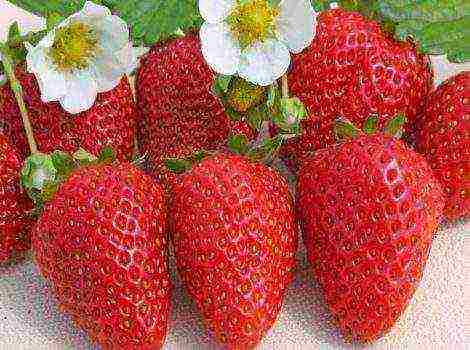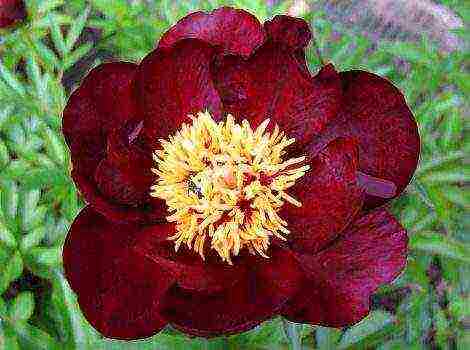Content [show]
Pumpkin is rightfully considered one of the most delicious and healthy vegetable crops. Moreover, it tastes equally good both fresh and boiled, fried and baked. The composition of the pumpkin contains a large amount of substances and vitamins necessary for the human body, so it should grow on the site of every gardener. They love pumpkin in different regions of Russia, and this gives a reason to take into account the climatic features of each area. The volume of the crop that the farmer can count on depends on the growing conditions.
The best varieties of pumpkin for open ground
Siberia and the Urals
Siberia is a very special territory characterized by extremely long frosts. Frosts in this area continue until the first month of summer. This important factor must be taken into account when choosing a vegetable variety. The main qualities of the planting material for Siberia are frost resistance. Several varieties of pumpkin are ideal for these parameters.
Smile
Pumpkin variety Smile
The peculiarity of Smile is that this variety is not only cold-resistant, but also high-yielding. In addition, it is characterized by a short ripening period - after the sprouting of the first shoots, it takes only three months until the pumpkin can be eaten. At the exit, the farmer receives medium-sized (from half a kilogram to two kilograms) orange fruits with dense and sweet pulp. Pumpkin Smile can be stored until January - however, it is unlikely that it will "live" right up to winter - it is too tasty.
Pumpkin Seeds Smile
Initially, the Smile variety was bred as an ornamental variety, and it corresponds to its purpose. On the site, the plant looks spectacular - large leaves with an outstanding pattern, large bright flowers and an intoxicating aroma. And the fruits are a real work of art. A lot of them immediately appear in the garden - up to fifteen pieces. With proper care, the Smile variety gives up to three kilograms of fruit from one bush.
Pumpkin Smile - early ripening variety
Freckle
Pumpkin variety "Freckle" refers to early ripe pumpkins
The "Vesnushka" variety is also well suited for Siberia and the Urals. Three-kilogram fruits ripen quite quickly and differ in their characteristic appearance - the green peel is "diluted" with light spots. The pumpkin flesh is soft, juicy, tender and has a delicate pear flavor. Among other advantages of this variety, there is a high yield, subject to abundant watering and long-term storage at room temperature.
Pumpkin variety "Freckle"
Russian woman
Pumpkin Rossiyanka also belongs to cold-resistant, as well as early-maturing varieties. The ripening period is about three months. The fruits of the Russian woman are quite large - from two to four kilograms. At the same time, up to twenty kilograms of fruit are obtained from one bush with proper care - impressive results. The pumpkin grows bright and tasty - delicate sweet pulp with a melon aroma.
Pumpkin "Rossiyanka" - early ripe pumpkin, climbing, lying, tasty, versatile
Farmers advise sowing the crop in April so that it can be planted in the ground in May-June. In this case, you can fertilize the soil with organic fertilizers, then the harvest will be richer. If you want to store the pumpkin for a long time, then provide suitable conditions for this - dry air and a room that is well ventilated.
Pumpkin seeds "Rossiyanka"
Moscow region and the Middle Strip
For these areas, there are also pumpkin varieties that thrive best in these climatic conditions.
Therapeutic
Healing pumpkin. Description of the variety
A characteristic feature of this pumpkin in its shape is a little flattened, it is always easily recognizable among other fruits. Farmers highly value the Healing pumpkin for its excellent taste, rich smell, bright color, as well as for its practical quality - early ripening (about three months). Outwardly, the pumpkin is easy to recognize not only by its specific shape, but also by the gray-green color of the peel with a unique pattern.
Healing
Another excellent early-ripening variety is Healing pumpkin, which, like other "brethren", has excellent taste. Oval orange fruits without a pattern have a juicy flesh. The mass of one fruit is from 2.5 to 3 kilograms. The pumpkin can be easily stored without loss of taste for up to 6 months.
Healing pumpkin
If you want to harvest in August, then this pumpkin variety should be planted in June. It is important to choose a well-drained soil and preferably a sunny location. This pumpkin loves water, so don't skimp on watering. Experts advise to mulch the holes with peat, which will prevent rapid evaporation of water.
Sweet pie
Pumpkin "Sweet Pie"
A variety with a tasty name refers to early ripening, that is, it will take about 3 months for fruits, the average weight of which is from 2 to 3 kilograms, to ripen. Among the features of pumpkin are crispy and very tasty pulp, which is excellent for preservation. Farmers love this variety for its high and stable yield, but for this you need to provide it with proper care: regular watering, feeding, loosening and weeding. It is ideal to sow a sweet cake in such conditions when the soil reaches a temperature of 12 degrees.
Candied fruit
Candied fruit is a variety that is characterized by high yields and quick ripening (from 112 to 118 days). The fruits will be quite large - about 2 kilograms, so you need to sow seeds with this calculation. The flesh of the candied pumpkin variety is very tasty - juicy, crunchy and aromatic.
Large-fruited pumpkin "Candied"
Farmers recommend planting candied fruits on sandy loam and easily, loamy soil, since it is on this soil that the variety gives the richest harvest. After planting, you need to wait for the first shoots and remove weak plants, and the remaining ones should be watered abundantly, weeded, pinched and fed.
Premiere
If you are looking for a versatile pumpkin, then Premiere is the perfect option. Add to this the early maturity of the variety and the high yield, and you will no longer look for other pumpkin varieties. As a result, farmers receive large, smooth fruits with a high content of sugar, carotene and dry matter.
Pumpkin Premiere
It is necessary to sow seeds at a time when the threat of frost has completely passed, that is, not earlier than the end of May - beginning of June. In order to end up with large fruits and ripen quickly, you need to leave from 2 to 4 fruits on one bush. The premiere is kept well enough.
Gribovskaya winter
Pumpkin "Gribovskaya" winter large-fruited
Unlike other varieties described above, Gribovskaya Zimnaya belongs to the late-ripening varieties - the ripening period for fruits is from 128 to 140 days. However, at the same time, the plant is quite fruitful. The mass of one pumpkin is from 3 to 7 kg. Other advantages include good transportability and long-term storage.
Gribovskaya bush 189
Gribovskaya bush 189
This pumpkin variety is known for its unusual egg-shaped fruit. Ripe pumpkin has a light orange hue, ornately decorated with greenish patterns. The fruit tastes very tasty - sweet and juicy, as well as large enough - about 5 kilograms. They are characterized by high transportability and good keeping quality.
Experienced farmers assure that you need to sow the seeds of the variety in late May - early June.
Pumpkin Gribovskaya Bush 189
Dachnaya
The dacha variety is rightfully considered one of the earliest ripening - in 70 days after germination there will be the first harvest. The fruits are oval or ovoid, and in color they are yellow and only the stripes have a dark green tint. This pumpkin is very sweet and juicy. The average weight of one fruit is about 3 kg.
Pumpkin Country
Among the main advantages of the variety, farmers note its high yield, early maturity, and resistance to cold weather. To get a good result, you need to sow the pumpkin only when the ground warms up to at least 10 degrees. It is very important to water, weed and huddle the plant in a timely manner.
Northwest
Bush orange
The Kustovaya Orange variety has a very modest size. This is an early maturing plant that bears bright large fruits weighing about 4 kilograms. The pumpkin pulp is very tasty: juicy and sweet, and also has a high carotene content. The pumpkin bark is also delicious - sweet and crunchy.
Orange bush pumpkin
Among the advantages of the variety, one can note its early maturity and versatility, since the Bush orange pumpkin is used both fresh and baked, stewed and fried.
Trojand
The Troyanda variety is excellent for growing in the middle lane - in such climatic conditions, the plant gives a fairly rich harvest. The fruits on the bushes are large (up to 7 kilograms) and tasty. The most important advantage of the Troyanda variety is its disease resistance. Plus, the pumpkin can be stored for a long time.
Chit
Pumpkin variety Crumb
This variety was bred a long time ago - at the beginning of the 21st century. This is one of the few varieties that is completely "understandable" for farmers, since no unpleasant surprises can be expected from it. It is reliably known that the size of the fruits will be very modest and will hardly exceed three kilograms in weight.
Outwardly, it is a rounded flat pumpkin of light gray or almost white color. It is very tasty, juicy, soft, bright yellow. Differs in a high content of sugars and solids.
Acorn
This variety has another name, which is more common among the people - "acorn". The plant deserved it due to the external similarity of the fruits with acorns, of course, in different proportions. The pumpkin pulp has an orange-yellow pulp and a very pleasant sweet taste.
Acorn
As for the color of the peel, the options can be different: from green to orange. Sometimes these shades are bizarrely combined with each other.
Pumpkin Acorn in the garden - photo
Obviously there is a wide variety of pumpkin varieties that are suitable for outdoor use. Study the features of the local climate and, depending on this criterion, choose the plant that is guaranteed to take root in your area.
Video - The best pumpkin varieties for open ground
With a variety of shapes and colors, the pumpkin can amaze any gardener: round, flat, elongated, reminiscent of a guitar or a jug, yellow, bright orange, green striped, gray speckled. Many are lost in such a variety, not knowing which pumpkin is better to plant. The best pumpkin varieties with photos and descriptions will help every vegetable grower get a rich harvest of a garden beauty.
Types of pumpkins
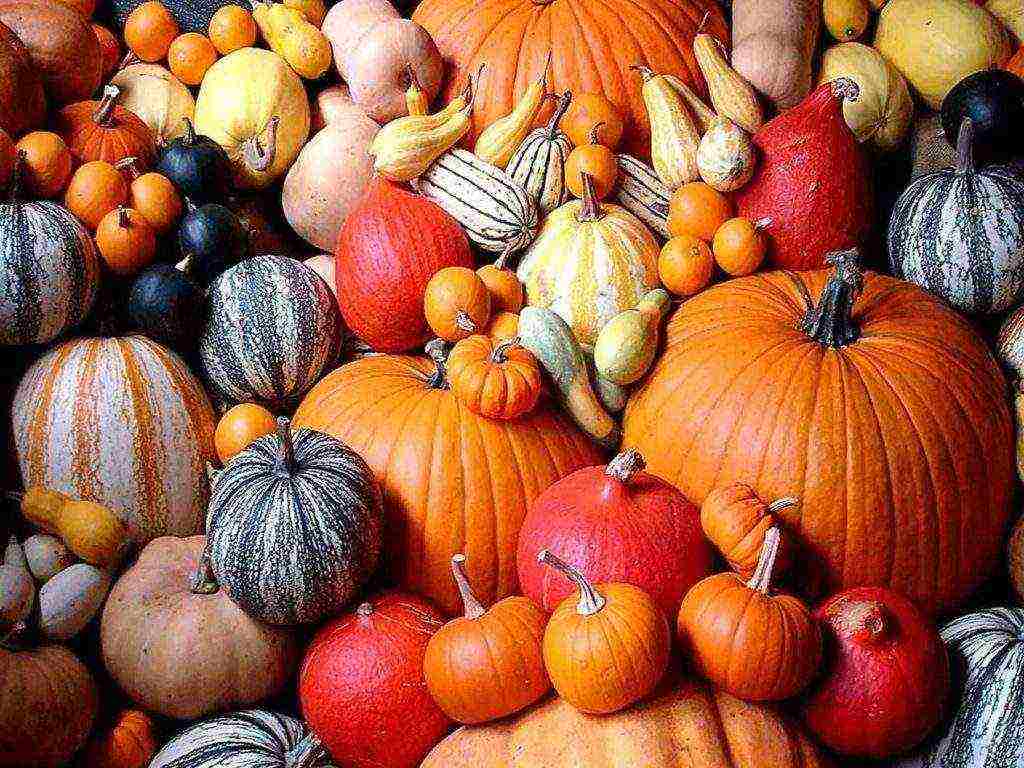
On farms, fields and gardens around the world, there are three varieties of pumpkins:
- firm-mouthed;
- large-fruited;
- nutmeg.
In each of these varieties there are bush and climbing pumpkins, portioned and with large fruits, with very sweet pulp or a large number of seeds, table, feed or decorative.
The choice of variety depends on the preferences and goals of the gardener. Those wishing to enjoy boiled, stewed or fried pumpkin in the summer, having prepared only seeds for the winter, it is better to plant more hard-baked summer varieties.
Lovers of baked fruits and pumpkin juice are advised to choose nutmeg and large-fruited varieties in order to preserve the fruits until spring. Connoisseurs of fresh salads with pumpkin will love the sweet-fleshed gray-fruited varieties.
Hard Bark Pumpkin Varieties
This type of pumpkin owes its name to its very thick, woody skin when ripe. Hard-bore pumpkins are distinguished by their early ripening period (late August-early September), small fruit size and the most delicious seeds. The bush varieties found among this variety of pumpkins are very convenient to save space.
Hardy varieties have a ribbed stalk with pronounced grooves, a prickly hairy stem and pentagonal leaves. Cream-colored seeds have pronounced rims.
Altai
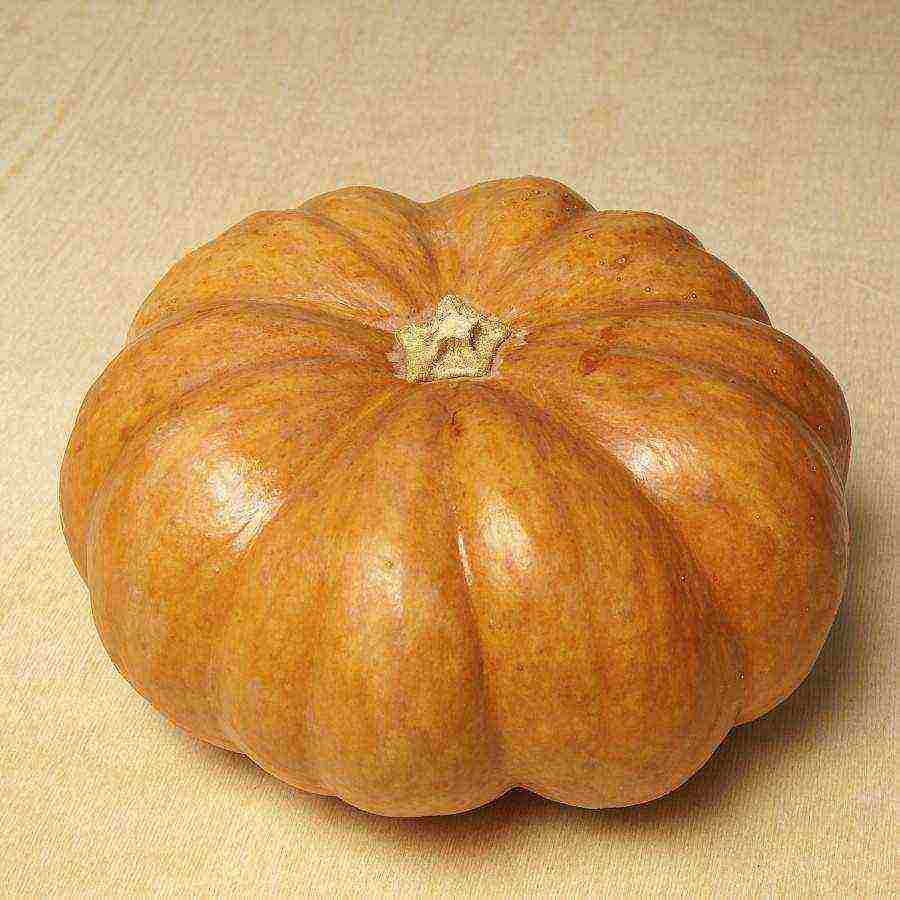
Yielding early maturing cold-resistant variety for universal use. Round, orange with yellow spots, ribbed fruits can weigh from 2.5 to 5 kg. The yellow, fibrous flesh is not very sweet in taste. The fruits are of high keeping quality.
Acorn
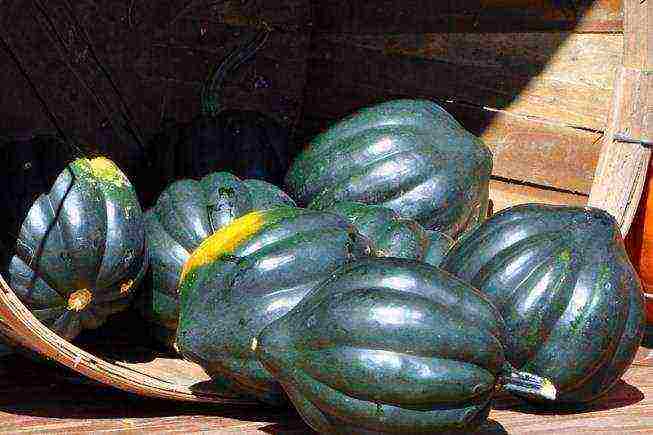
For the external similarity of small fruits with acorns, this pumpkin is called "acorn". The outer skin of the fruit can be dark green to orange in color. The pulp is yellow-orange in color and has a sweet taste.
Aport
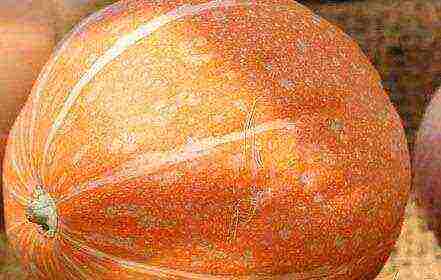
A mid-ripening bush pumpkin of an almost round shape with an orange peel without a pattern and fruits growing up to 7 kg. The pulp is orange-yellow, crispy, juicy. The taste is sweet, with pronounced creamy notes.
Gymnosperm

Mid-season variety with pear-shaped or spherical fruits of dark green or green in a yellow mesh color with orange-yellow delicate sweet pulp. It is prized primarily for its fleshy, large, skinless seeds with a high oil content.
Smile
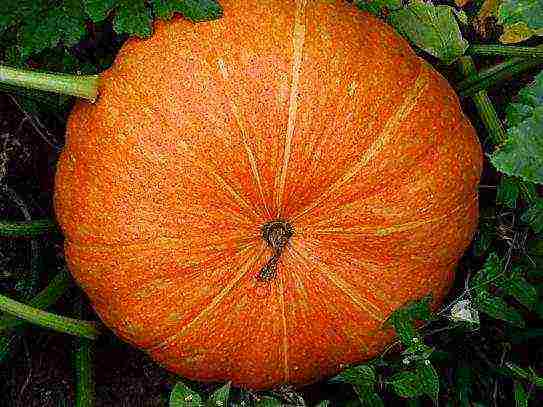
Early ripening in 85 days with small neat bushes. One plant produces 7-8, and sometimes up to 15, small, bright orange pumpkins with light stripes with an average weight of about 1.5 kg.
Beautiful flowers and good keeping quality are characteristic features of this variety. The fruits can lie until January at room temperature without losing flavor. The pulp is 3-4 cm thick, fragrant, crispy, sweet.
Spaghetti
A variety with a "self-explanatory" name, the pulp of which breaks down when cooked into fibers that resemble spaghetti. In shape and color, the fruit is similar to a melon. Unripe pumpkins have a greenish color; fully ripe pumpkins acquire a light yellow color.
Freckle
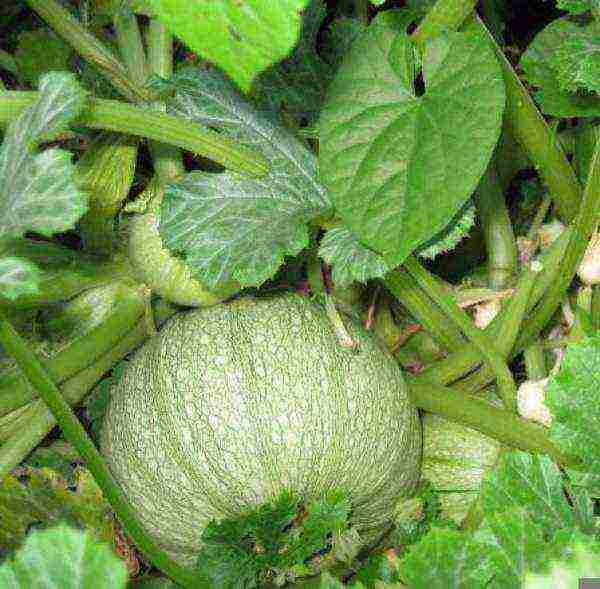
Shrub early ripening variety with small fruits weighing up to 3 kg with a light green peel with light spots.The pulp is yellow-orange, with a sweet delicate taste and a pear bite. The variety loves good watering, productive, excellent storage.
Bush Gribovskaya 189
An early maturing variety that gives the first harvest in 98 days. Elongated oval fruits with a light orange peel with black and dark green spots weigh about 4 kg. Orange pulp with excellent taste.
Dachnaya
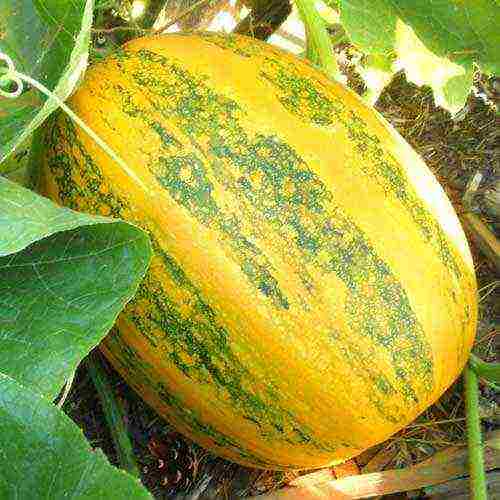
The variety is mid-season, the fruits are orange-green, oval, weighing 4.5 kg. The bright orange pulp is tender, juicy, has a great taste and vanilla aroma. The variety can be grown in all regions with high yields. The palatability is retained for 4 months after harvest.
Bush orange
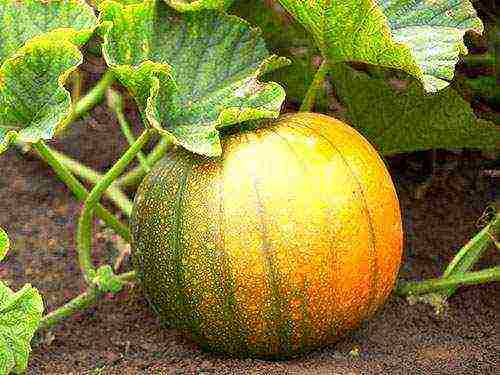
Short-growing early maturing plant with compact growing bushes. Large orange fruits weigh up to 5 kg. Orange pulp up to 7 cm thick has excellent taste. Pumpkin is unpretentious to growing conditions, it tolerates drought well. Stored for a long time without losing taste.
Almond

A mid-season, universal variety with long lashes and round orange fruits weighing 4-5 kg. The orange-yellow crunchy juicy pulp has a sweet taste. Fruits are well stored for a long time, perfect for baby food and juicing.
Mozoleevskaya
Mid-early climbing pumpkin with yellow ovoid fruits with dark green stripes with an average weight of 4-5 kg. The pale orange dense pulp is rather sweet in taste (sugar content reaches 6-7%). The variety is distinguished by high keeping quality and good transportability.
Large-fruited pumpkin varieties
Large-fruited pumpkins are distinguished by the largest sizes and the sweetness of the fruit. Some varieties have a sugar content of about 15%, far exceeding the sweetest watermelon.
Large-fruited varieties are characterized by rounded cylindrical stalks, kidney-shaped or close to pentagonal leaves, rounded stems without grooves. Large pumpkins can have matte, milky white or brown seeds. This variety tolerates low temperatures better than others and can be stored in an ordinary apartment for a very long time.
Basically, these are unpretentious cold-resistant varieties with large fruits, the weight of some of them can reach 100 kg.
Arina
An unpretentious, disease-resistant early climbing table variety with rounded light gray smooth or slightly segmented fruits with an average weight of 3-5 kg. The yellow firm flesh has a sweet taste. Long and well-kept. Seeds are high in oil.
Roll
An early versatile bush variety with spherical gray, slightly segmented fruits weighing about 10 kg. The pulp is juicy, yellow, not very sweet. Mainly grown for the oil-rich seeds.
Big Moon
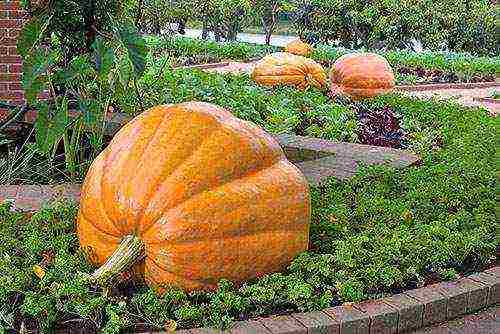
An unpretentious medium-late variety in cultivation with powerful whips up to 3 m long. Very large, slightly segmented or smooth yellow fruits weigh 15-40 kg (some can reach 90 kg). The yellow-orange juicy and firm pulp has a good taste.
Dawn
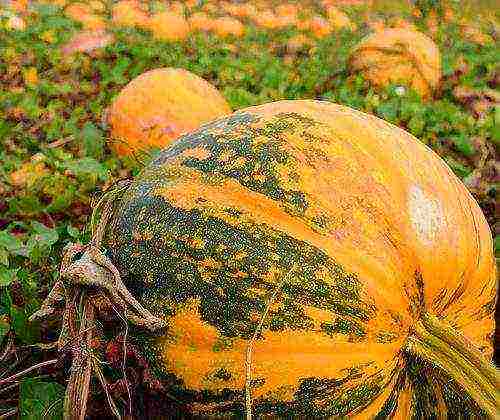
A very early large-fruited table variety with long, powerful whips. Dark gray fruits with orange spots reach a weight of 5-6 kg. The dense, bright orange pulp contains 12-14% sugar. The value of the variety is its exceptional sweetness and high carotene content. The fruits are used to prepare baby food dishes.
Russian woman
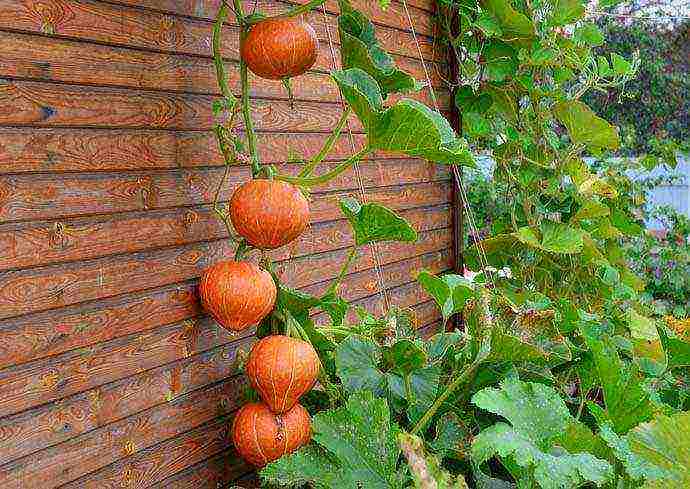
Climbing early-ripening pumpkin weighing 3-4 kg, resembling a bright orange top in shape. The sweet orange pulp has a delicate melon flavor. The variety is cold-resistant, high-yielding.
Ordinary
The most common variety, the fruits of which can weigh about 25 kg. Sweeter and tastier than a small pumpkin.
Gribovskaya winter
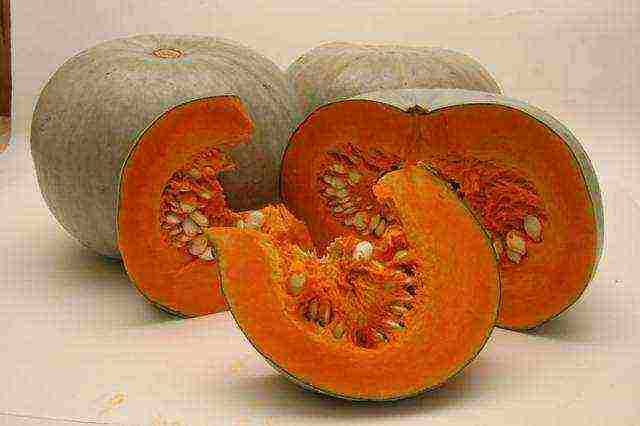
A late-ripening variety that ripens in 140 days. The plant is long-leaved, with flattened gray fruits weighing more than 3 kg. The pulp is reddish or bright yellow, up to 6 cm thick, dense, tender, juicy, sweet. Stored well.
Children's gourmet
Yielding mid-season table variety with round small (up to 3 kg) orange fruits with green stripes. The pulp is firm, pale orange, sweet, juicy. The fruits have excellent taste. Can be eaten fresh.
Amazon

An early ripening variety with high palatability with short (no more than 1m) lashes and portioned slightly flattened orange fruits with light stripes. The crispy, bright orange flesh has a high carotene and sugar content. Suitable for long-term storage. Can be eaten fresh.
Winter sweet
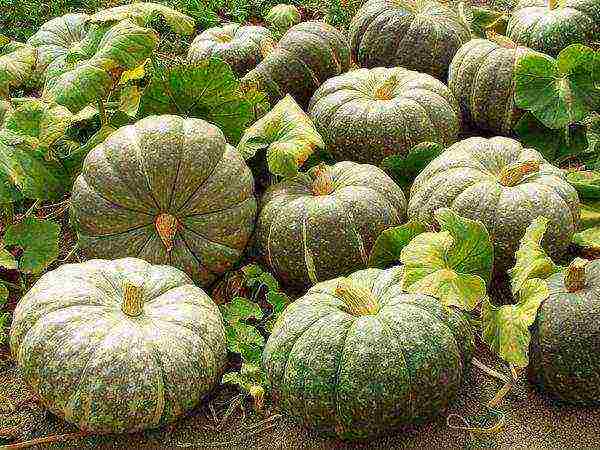
A late-ripening long-flowered variety with flattened fruits weighing about 6 kg and a dark gray skin divided into segments. The plant tolerates drought well. The pulp is orange-yellow, thick, juicy, sweet, with excellent taste. Recommended for making juices and baby food.
Therapeutic
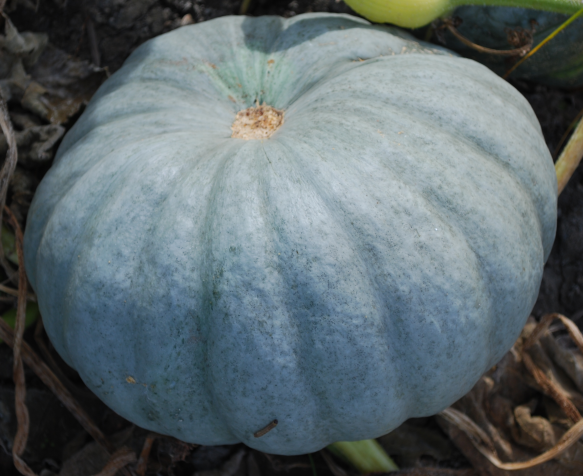
An early maturing variety with a thin gray skin, recommended for dietary nutrition. Fruit pulp is orange, juicy, crispy, sweetish in taste. The variety is resistant to low temperatures (up to -2 degrees), well stored.
Merchant's wife
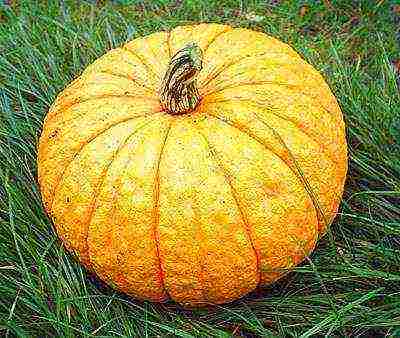
Recommended for growing in various regions, mid-early variety for table use. Fruits are light orange, smooth, flattened, weighing 15 kg or more. Good taste. It can be stored for up to 5 months.
Sweetie
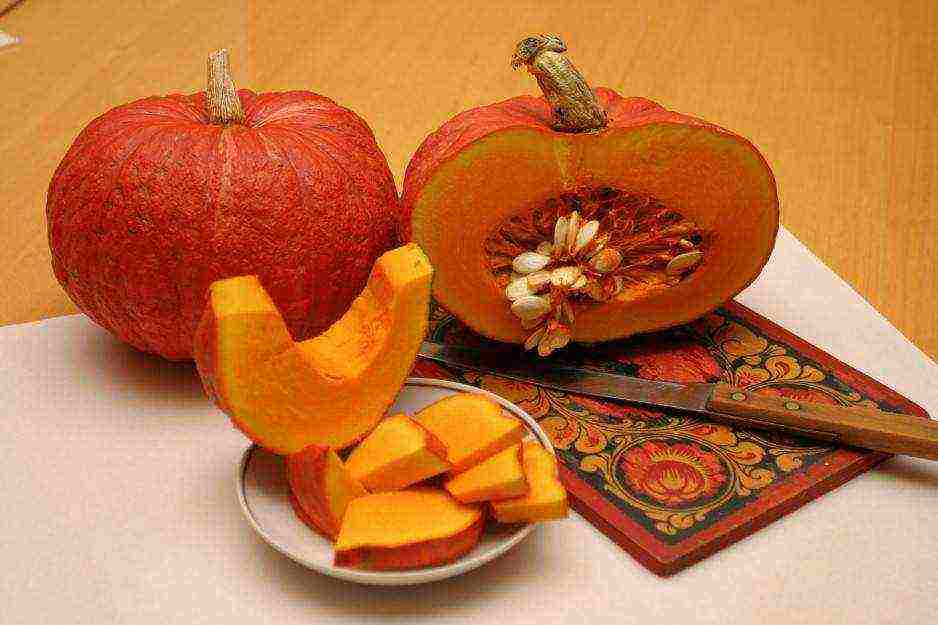
A high-yielding early-ripening long-growing variety that grows well on fertile soils. Fruits weigh on average 2.5 kg, ripen up to 8 pieces at a time. The peel is reddish with green spots. The pulp is bright orange, very tasty, dense, crispy, juicy. Contains a lot of vitamin C, 1% carotene, 8% sugars.
Parisian gold
Mid-early variety resistant to unfavorable conditions with long, powerful lashes, yellow-orange flattened fruits with pronounced segmentation weighing 8-10 kg. The thick yellow-orange pulp is rich in vitamins and has excellent taste.
Potimaron Red sun
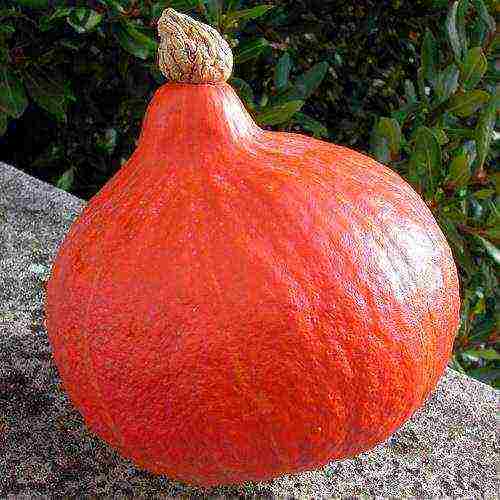
Medium late table variety with small orange fruits weighing 2-3 kg with an elongated neck. The yellow firm flesh is sweet in taste. Without loss of taste, the fruits can be stored until January.
Winter dining room
A late-ripening climbing pumpkin variety with flattened, segmented, light gray fruits that may have green or pink stripes. The orange flesh is very firm and sweet. The variety is distinguished by good transportability and high keeping quality.
One hundred pound
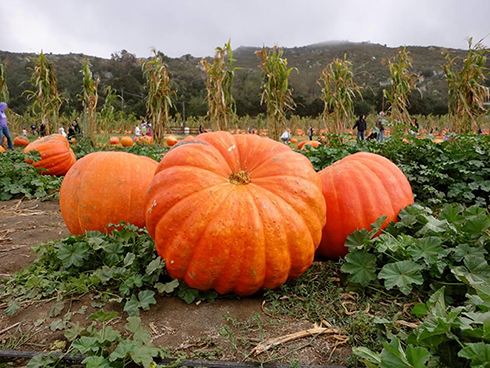
Late-ripening long-flowered universal variety with smooth oval slightly segmented fruits of white, yellow, gray, orange or pink color, weighing 6-10 kg. Thick orange or white-yellow flesh tastes slightly sweet.
Kherson
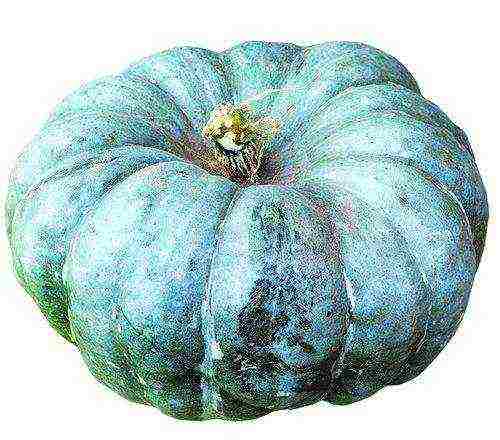
Climbing pumpkin of medium late ripening with flat gray-green fruits with gray spots weighing 4-6 kg. The pulp is orange, crispy, sweet, juicy, very pleasant to the taste. The variety is thermophilic, drought-resistant. Stored well.
Volga gray
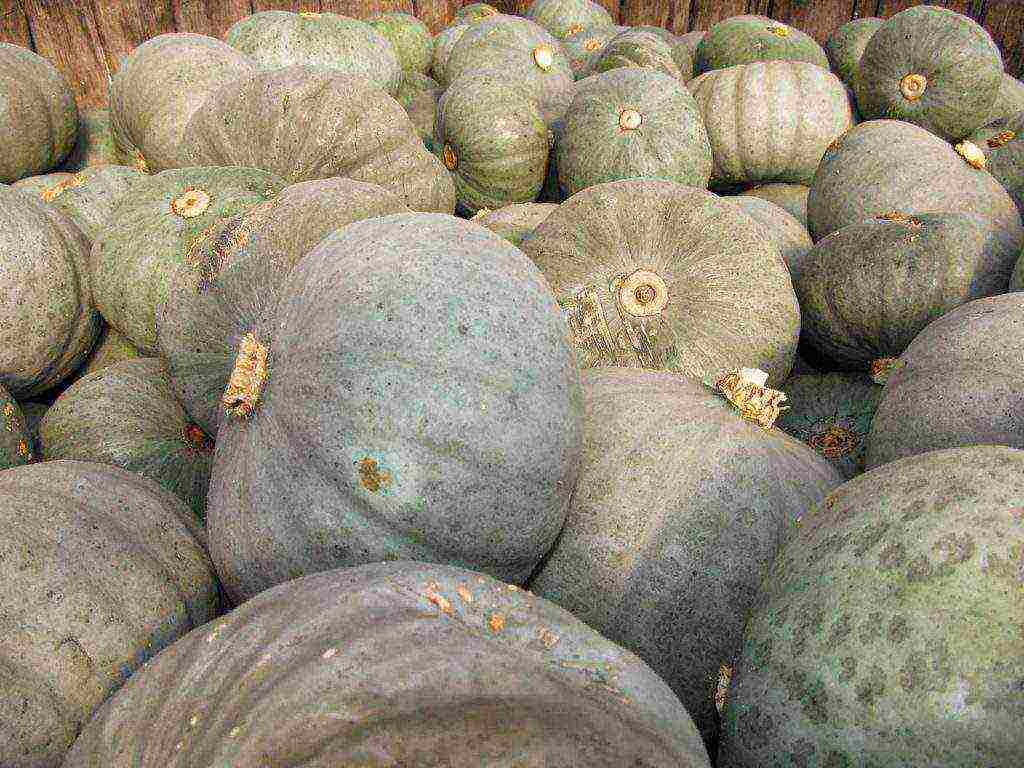
A drought-resistant mid-season variety with lashes reaching a length of 8 m. Fruits are almost round, light gray, weighing about 8 kg. The pulp is yellow or orange, juiciness and sweetness are average. Stored well.
Chit
Mid-season climbing variety with light gray flat fruits weighing up to 3 kg. The pulp is yellow, firm, sweet, not very juicy.
Marble
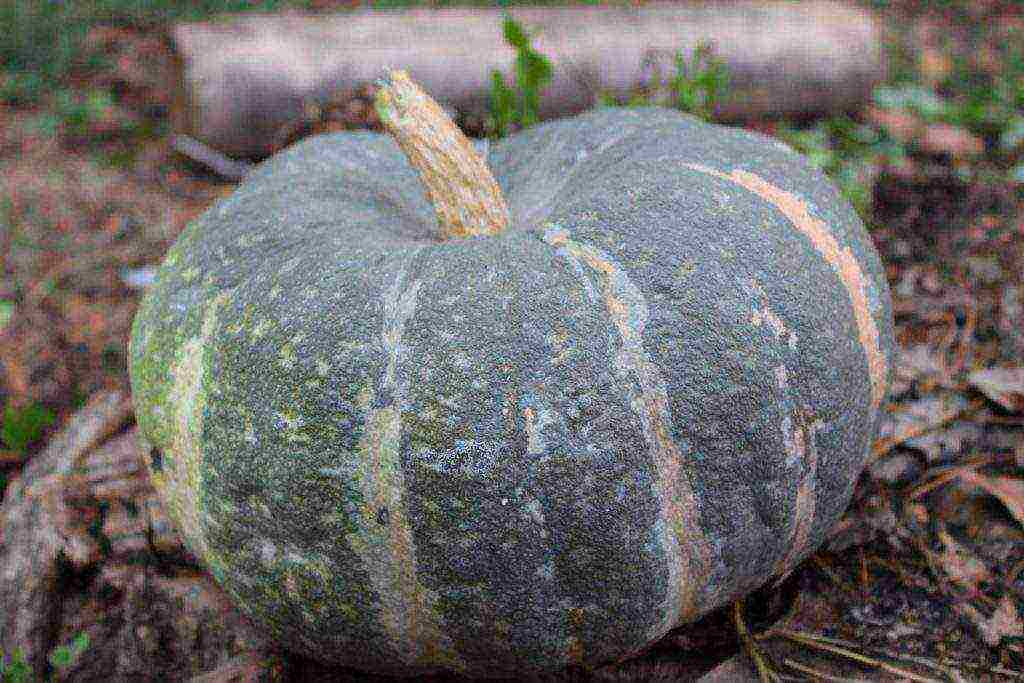
A high-yielding late-ripening long-growing variety with lumpy dark green round segmented fruits, the average weight of which reaches 3.5-4.5 kg. The rich orange pulp is very dense, very sweet and rich in carotene. The fruits can be eaten fresh.
Altair
A very juicy and sweet pumpkin with a yellow-orange gray skin. Can be eaten raw.
Centner
An early ripening universal variety with very large fruits that can reach gigantic (up to 100 kg) sizes.It is grown mainly for the seeds.
Titanium
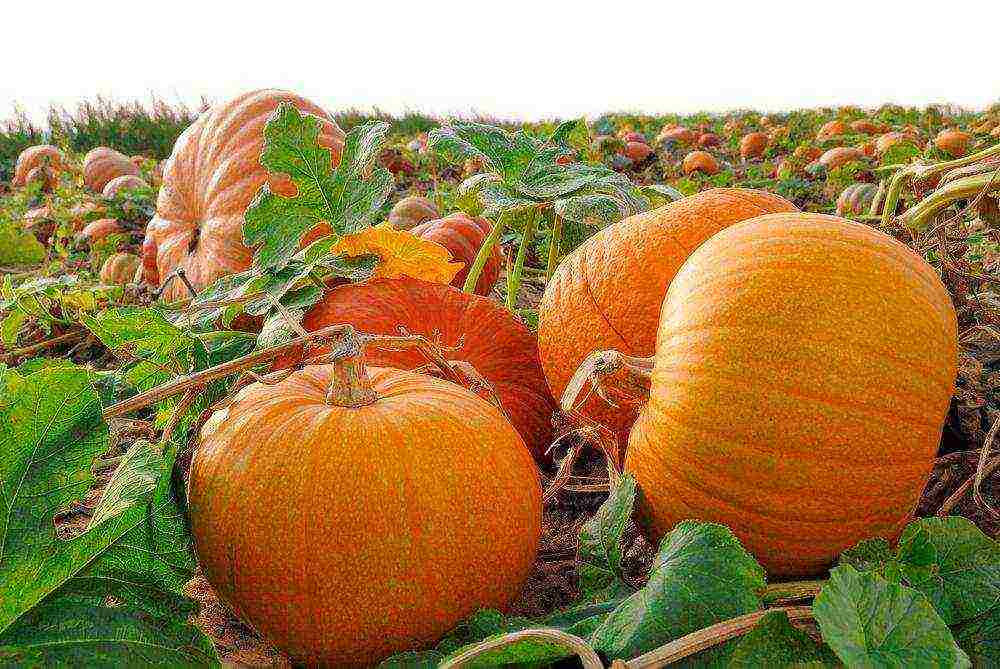
A universal mid-season variety with long lashes and huge spherical segmented fruits weighing 20-50 kg. The thick yellow flesh is quite sweet in taste. To grow a giant, it is recommended to leave only one fruit on the whip.
Butternut pumpkin varieties
These pumpkins have excellent taste, long shelf life, but they are more capricious to grow and are more suitable for the southern regions. Butternut squash can be eaten raw. Despite the fact that they are so sissy, they can be grown in harsh climates, only through seedlings. It is allowed to remove the fruits a little unripe: they will ripen at home.
For nutmeg gourds, a pentahedral stalk extended towards the base is characteristic. The color of the seeds of butternut squash is brownish or off-yellow.
Pineapple
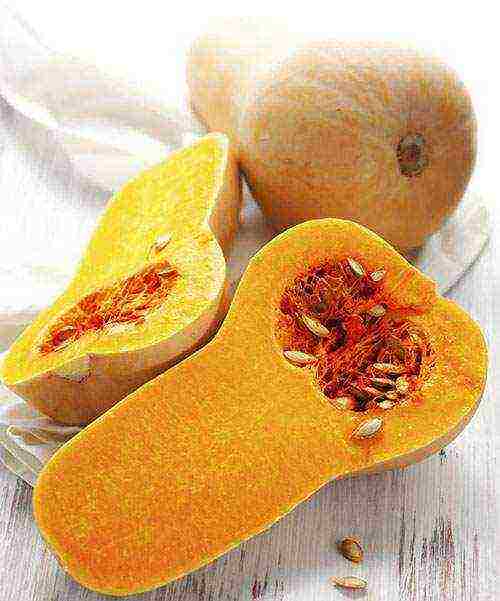
A disease-resistant mid-season long-leafed pear-shaped hybrid weighing up to 2.5 kg. The bark of the pumpkin is yellowish or creamy, the pulp contains about 10% sugar.
Butternut
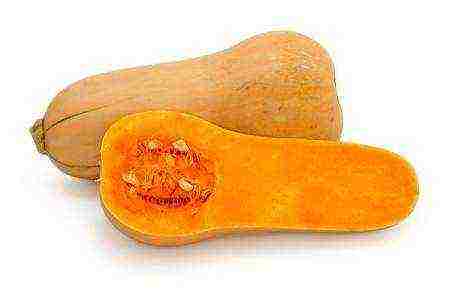
This variety with outwardly pear-like fruits can be found under the names Muscat or Nut. Small pumpkins weighing up to 1 kg have an external resemblance to a pear. The orange pulp is sweet, juicy and aromatic. The fruits can be baked, stewed, boiled, but it is best eaten raw: they contain a lot of useful minerals and vitamins.
Bylinka
A juicy sweet variety with bright orange flesh and gray skin, which tastes great when raw.
Vitamin
Late-ripening long-leaved pumpkin variety with oval-shaped green fruits weighing about 6 kg. The bright orange pulp is very tender, sweet (about 7% sugar), crunchy. Due to its high beta-carotene content, it is useful for juicing, baby food and raw consumption.
Palav Kadu
Late table variety with orange large and round segmented fruits weighing about 10 kg. The sweet orange pulp is prized for its unprecedented juiciness and amazing taste.
Prikubanskaya
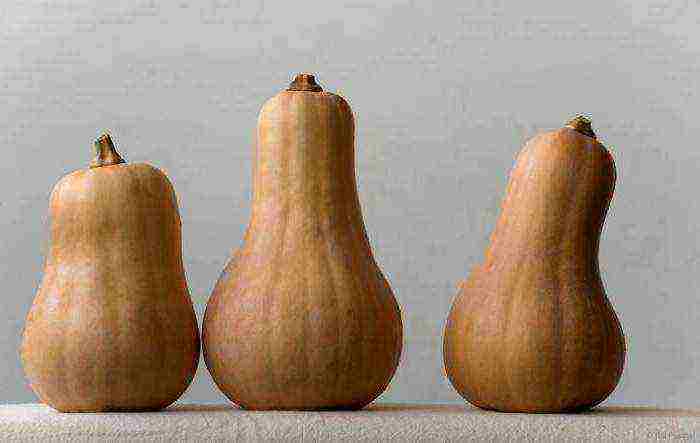
An old medium late nutmeg variety with long lashes reaching 3-4m. Orange-brown pear-shaped fruits weigh 2-5 kg. The red-orange tender pulp is juicy and sweet (6.5% sugar). Without loss of taste, it can be stored until the next harvest.
Sugar mace
An early ripe nutmeg variety that forms climbing plants with 7-8 fruits ripening at the same time weighing 1.5-2 kg. The pulp is juicy and sweet, rich in carotene and vitamins, can be used for baby food, juices and various culinary processing.
Pearl
Mid-season nutmeg variety with classic pear-shaped fruits weighing 3-6 kg. The orange pulp will contain a lot of carotene and sugar. It tolerates dry periods well. Pumpkins are suitable for medicinal and baby food.
Ornamental pumpkin varieties
Ornamental pumpkin is a modified variety of other types of pumpkins, most often the usual hard bark. These types of pumpkins were bred for beauty, taste was not taken into account in selection. Most ornamental pumpkins are not edible.
There are several varieties of decorative pumpkins:
Star (gourd crown)
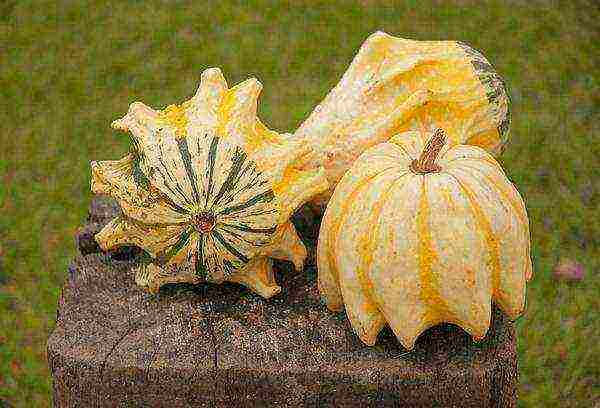
A curly type of decorative pumpkin, which grows up to 3-4 meters in height and is used to decorate arches, gazebos, walls of the house. The surprisingly small fruits of an umbrella-shaped, star-shaped, crown-shaped shape do not exceed 15 cm in diameter.
Warty gourd
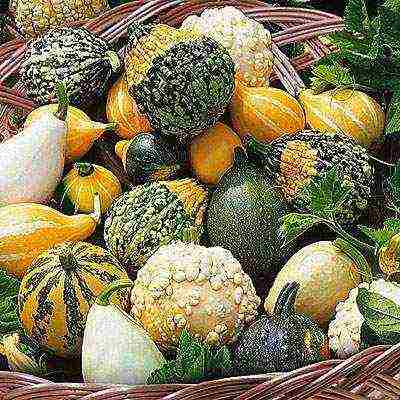
Small pumpkins of various shapes and colors with an uneven surface covered with nodules and tubercles. The fruits are dried and used for decorative purposes.
Turtle gourd (chump)
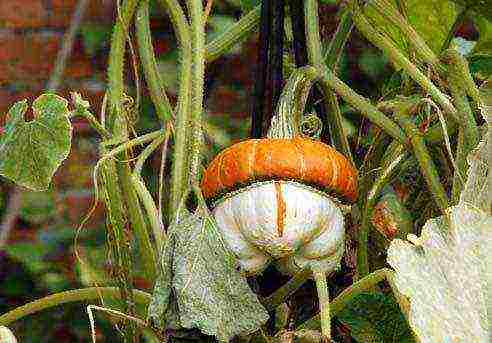
It can have completely different sizes and colors. Consists, as it were, of two parts: in "fungi" the upper part is larger than the lower, in turban-shaped ones the lower part is larger. The climbing plant grows up to 2.5 m.
Pear-shaped
A type of pumpkin that looks like a large smooth pear: yellow, red, bicolor or striped.
Tangerine
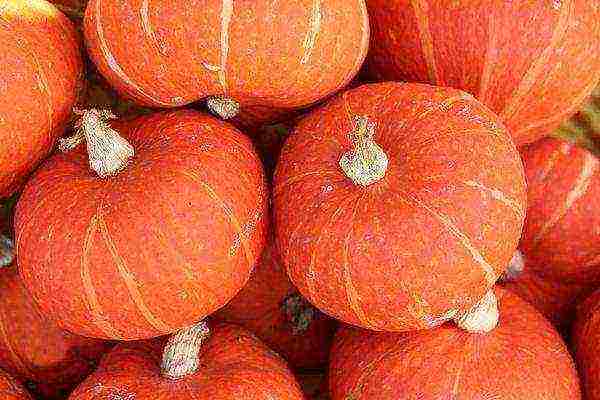
The diameter of mandarin pumpkins is no more than 10 cm, the peel of the fruit is smooth and slightly ribbed.

We invite you to familiarize yourself with the description of the most popular pumpkin varieties. Probably, there are no summer cottages in Russia where the pumpkin grows. Its history goes back many centuries. It is known that pumpkin was used by the inhabitants of the Mayan tribe, knowing about its healing properties. This vegetable has a great advantage among all the others - it can be stored for a long time, and you can eat not only juicy pulp, but also the most useful seed for food.
Content:
General information and classification 
Decorative varieties
The pumpkin family includes 27 species. A huge number of varieties have been bred from each.
In our country, 3 types of pumpkin are most often grown:
- large-fruited
- nutmeg
- ambulance
By purpose, pumpkins are divided into:
- table varieties
- fodder
- decorative
We will describe different varieties for cultivation in different regions of Russia, taste, etc.
back to menu ↑ Butternut pumpkin 
Butternut squash
back to menu ↑ Spanish guitar 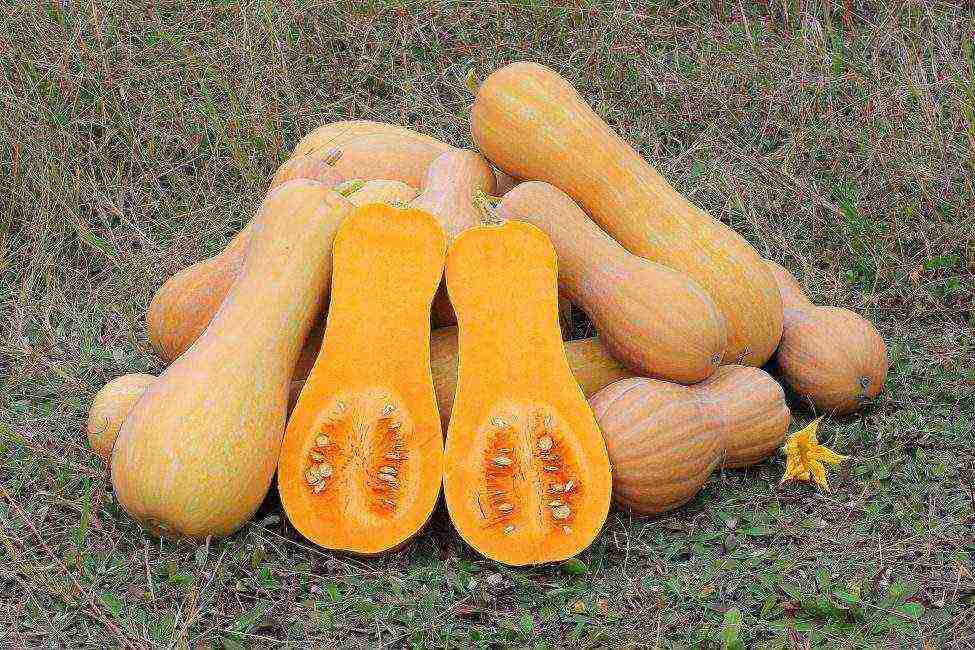
Spanish guitar
back to menu ↑ Candied 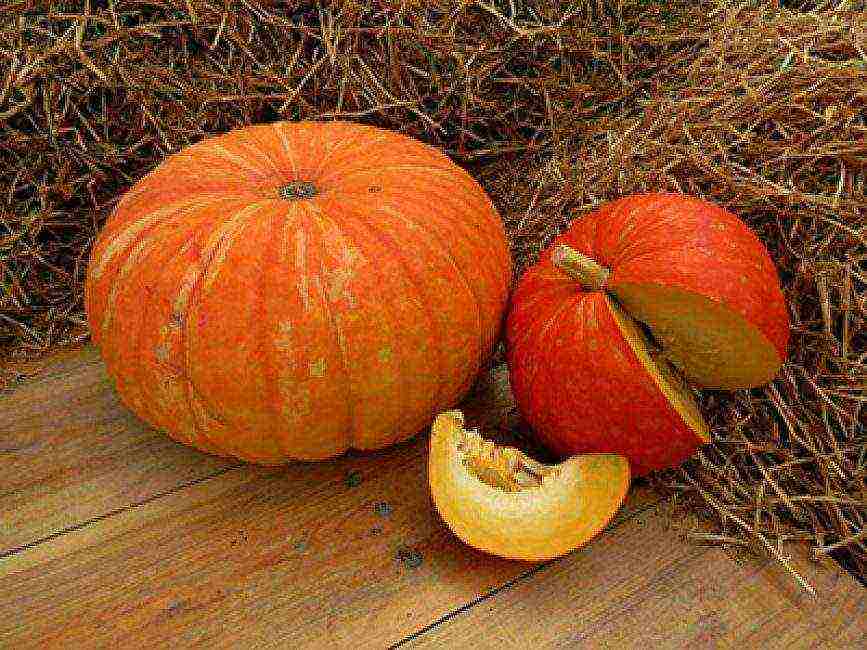
Candied
back to menu ↑ Vitamin 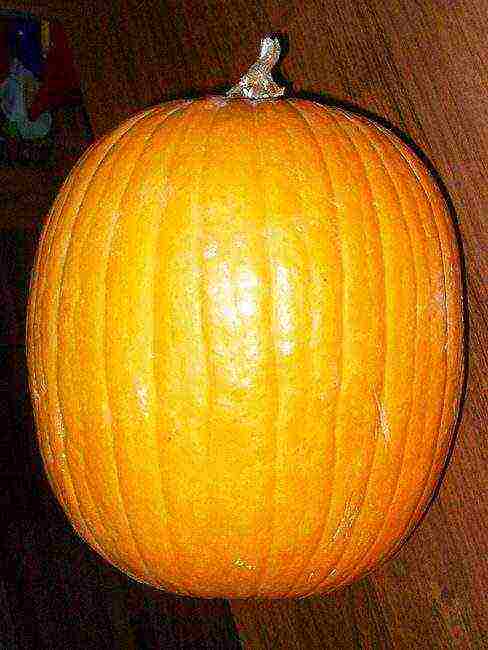
Vitamin
back to menu ↑ Marble 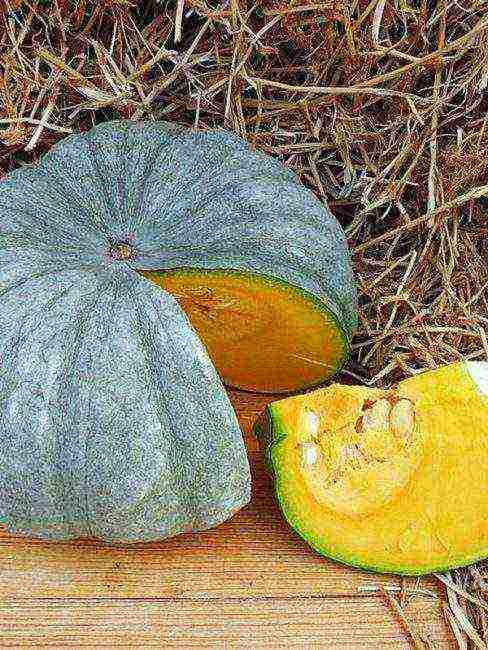
Marble
back to menu ↑ Muscat de Provence 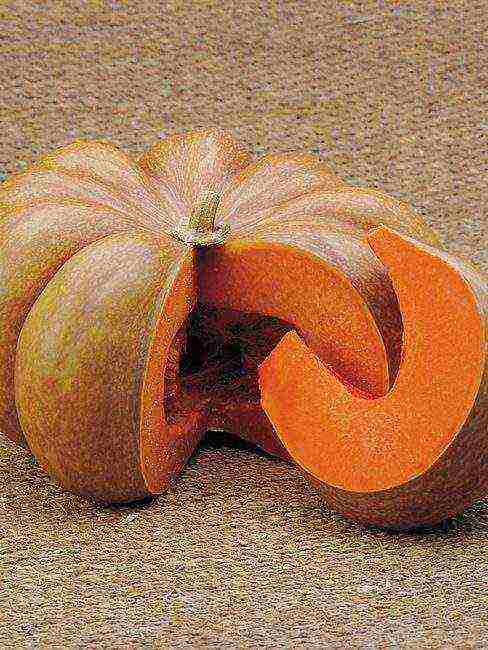
Muscat de provence
back to menu ↑ Nut 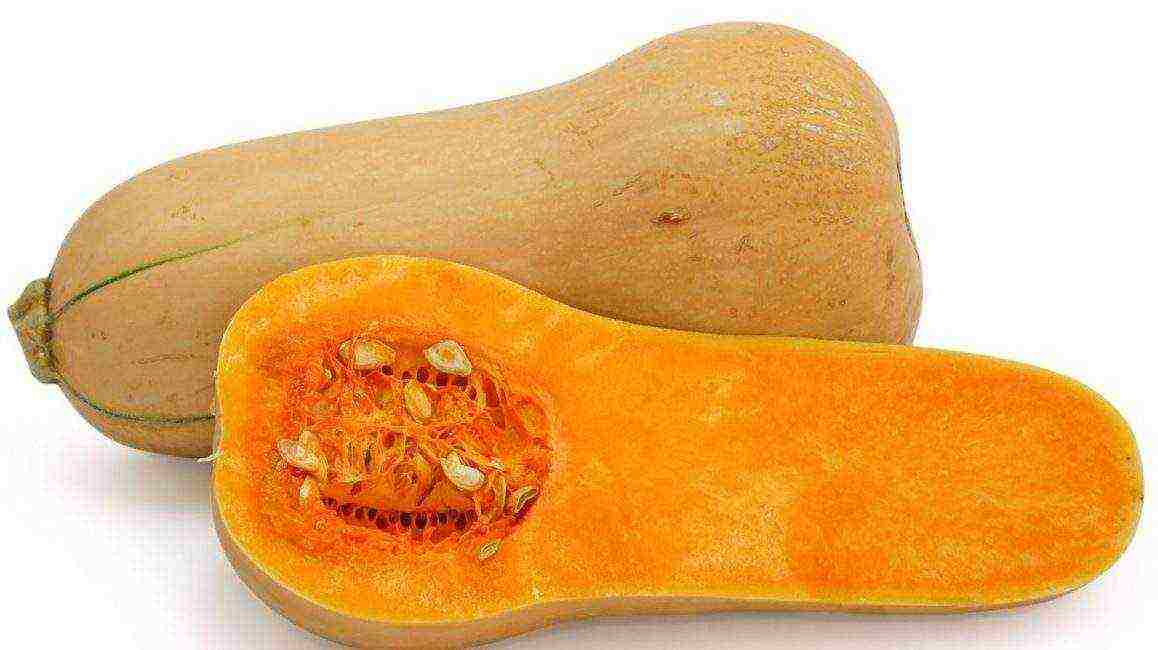
Nut
back to menu ↑ Varieties with large fruits 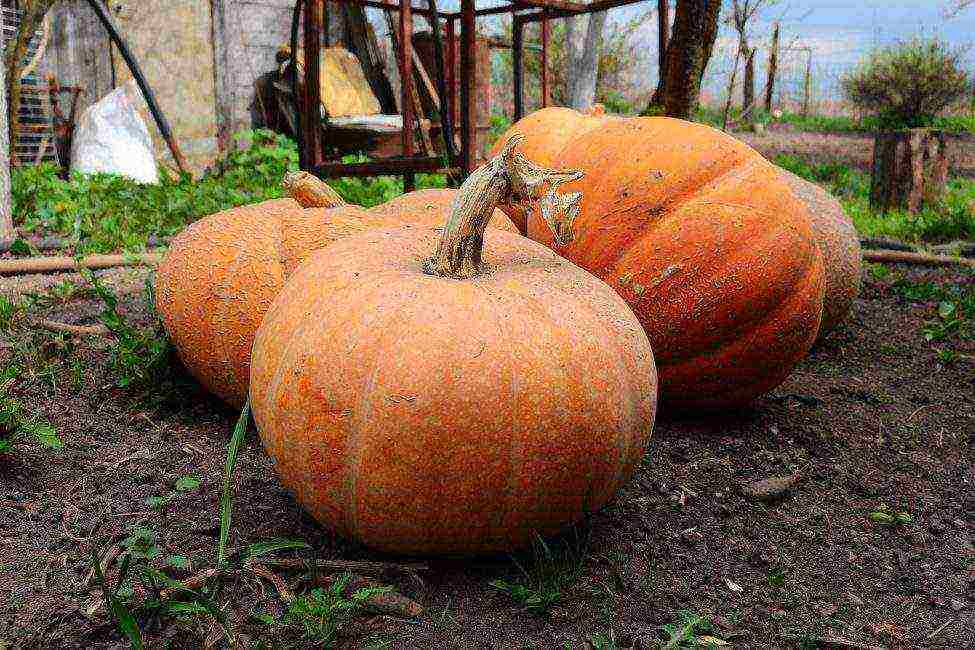
Harvested crop
back to menu ↑ Pumpkin lantern 
Pumpkin lantern
back to menu ↑ Russian porridge 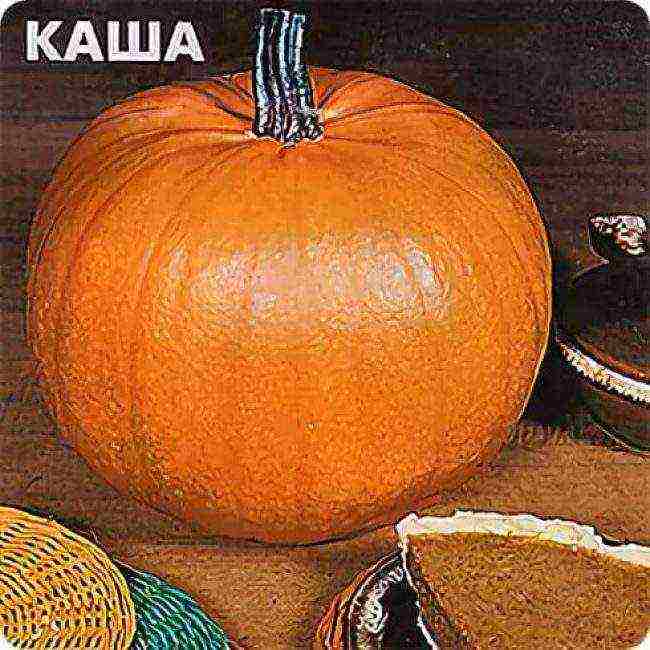
Russian porridge
back to menu ↑ Varieties of hard-barked pumpkin 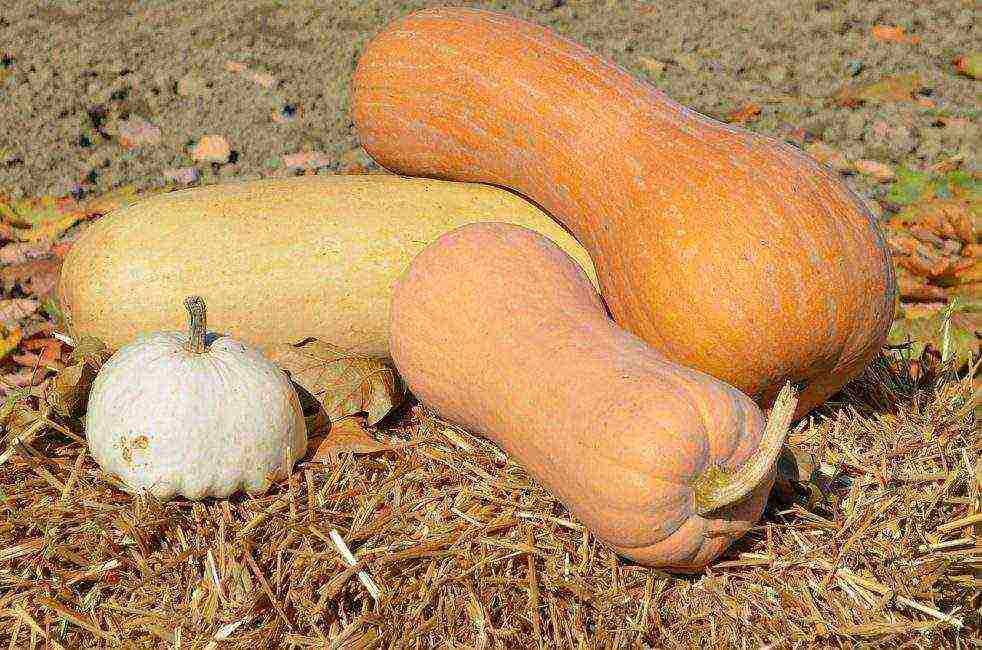
Zucchini, squash also belong to this group.
back to menu ↑ Bun 
Bun
back to menu ↑ Gymnosperms 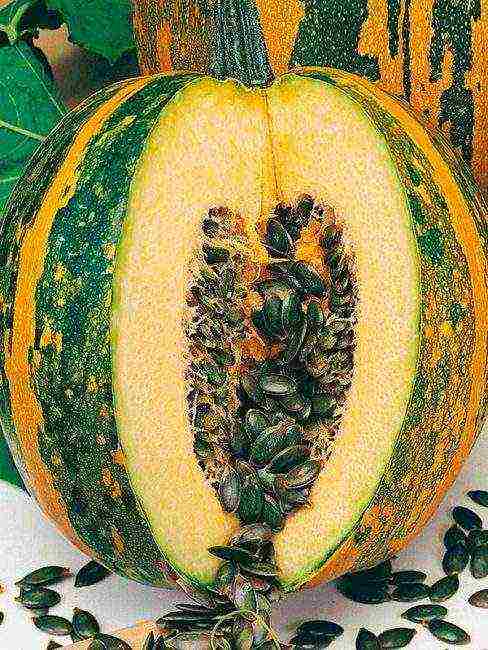
Gymnosperms
The most famous varieties of gymnosperms are:
- Danae
- Olga
- Miranda
- Hamlet
- Gymnosperm 14
back to menu ↑ Varieties for Moscow region 
Moscow suburbs
back to menu ↑ Baby 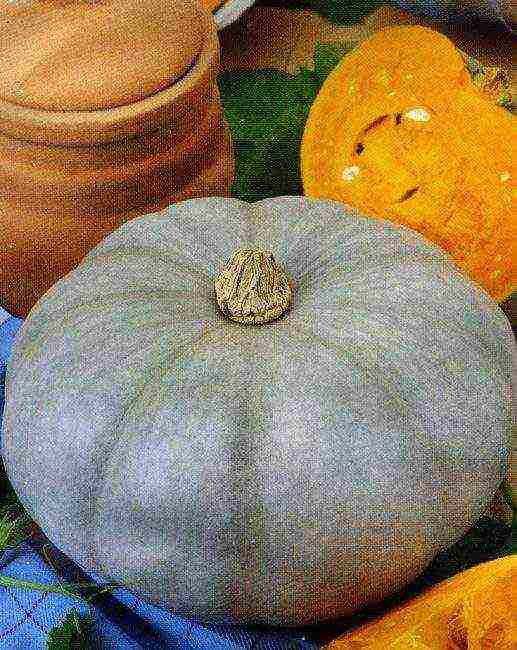
Chit
back to menu ↑ Sweet cake 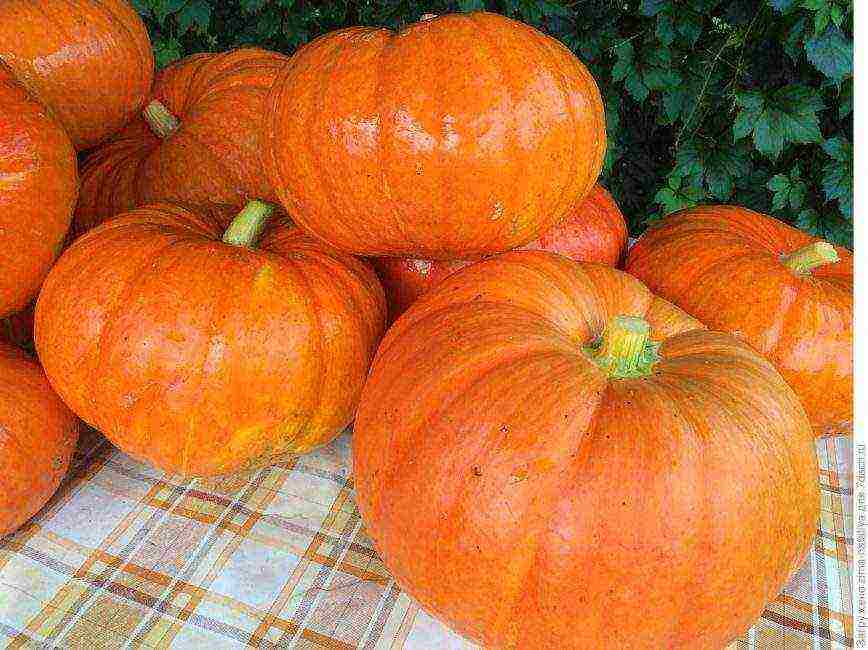
Sweet pie
back to menu ↑ Melon 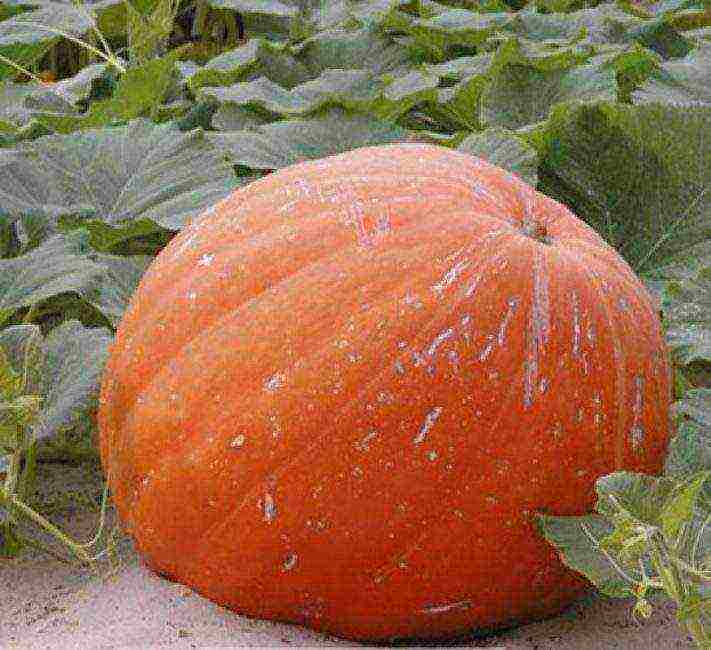
Melon
back to menu ↑ Champagne pastille 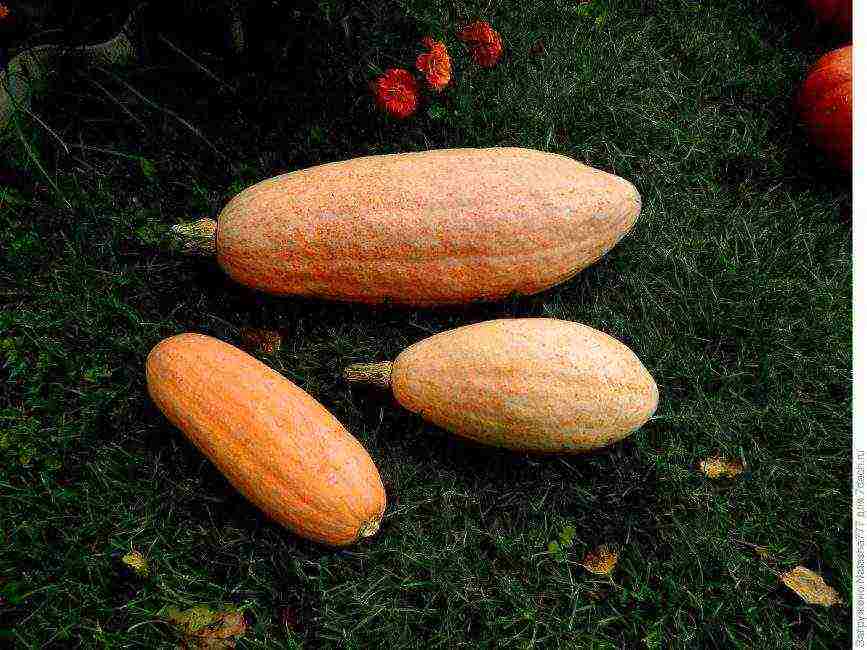
Champagne pastille
back to menu ↑ Zorka 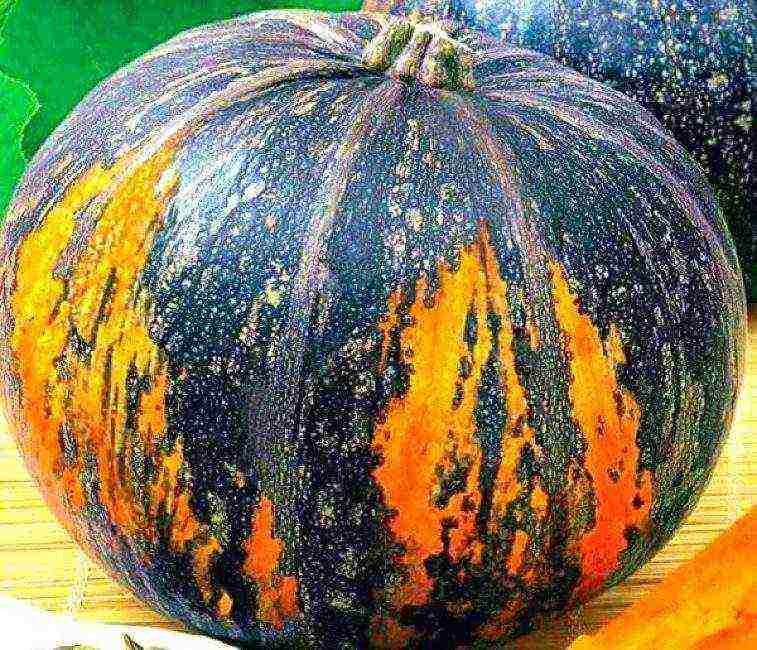
Dawn
The variety is considered resistant to various diseases:
- fusarium
- anthracnose
- powdery mildew
- rot
back to menu ↑ Almond 
Almond
back to menu ↑ Russian woman 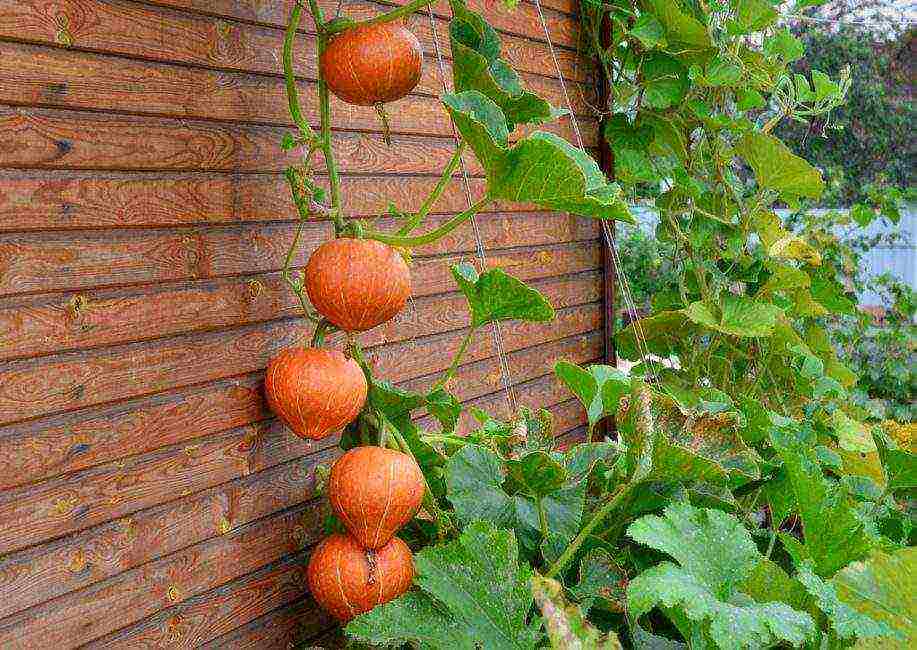
Russian woman
back to menu ↑ Varieties for Siberia, Urals 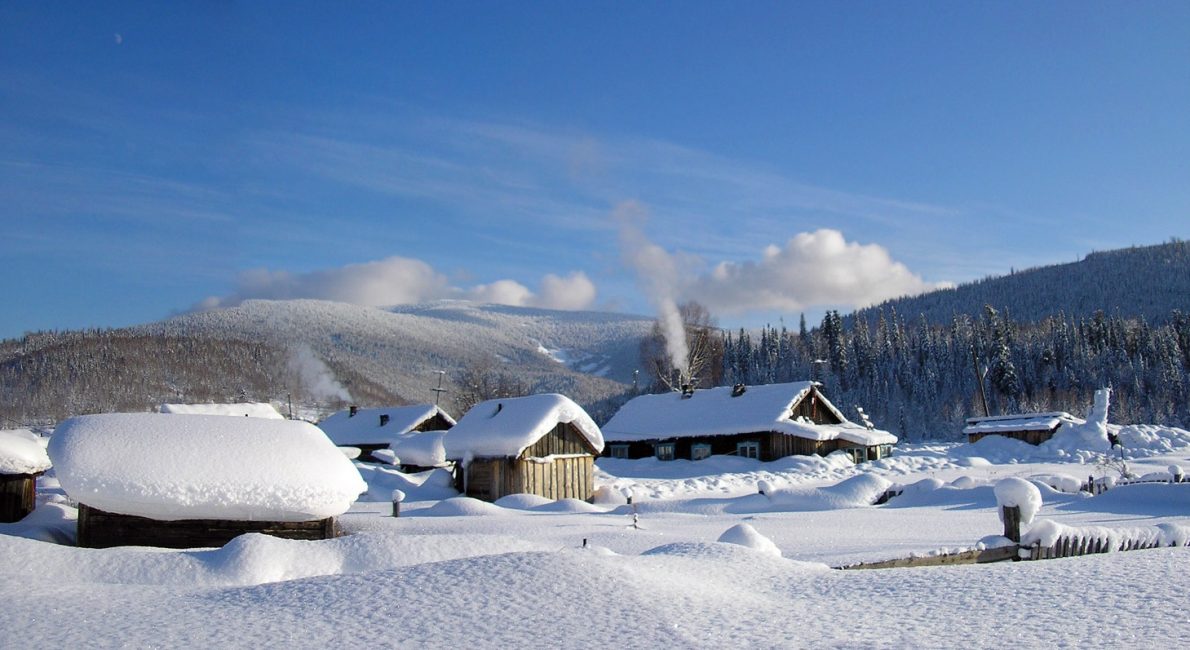
Siberian winter
Let's consider some varieties suitable for these regions of the country:
back to menu ↑ Medical 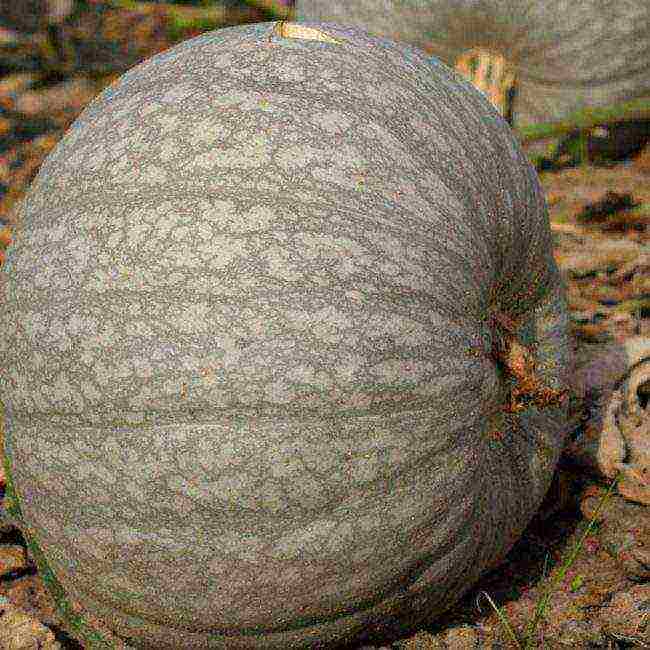
Therapeutic
The plant is not resistant to:
- decay
- anthroknose
- powdery mildew
back to menu ↑ Pearl 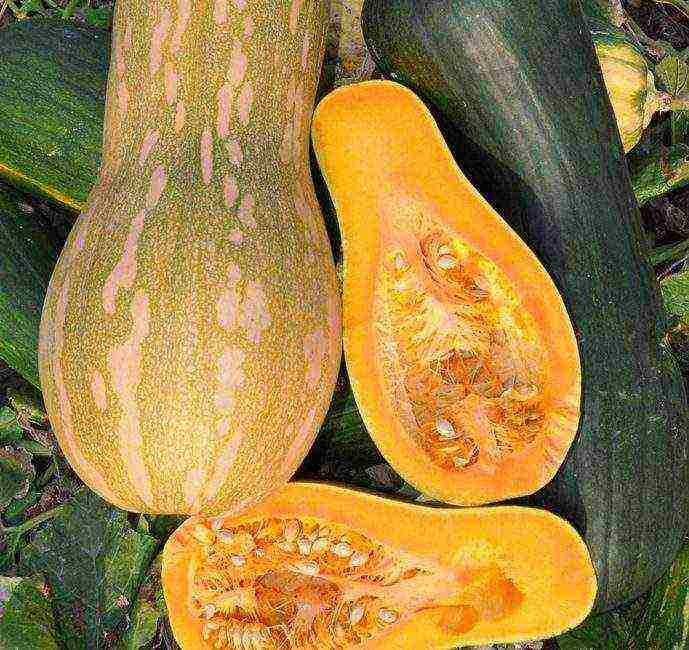
Pearl
back to menu ↑ Smile 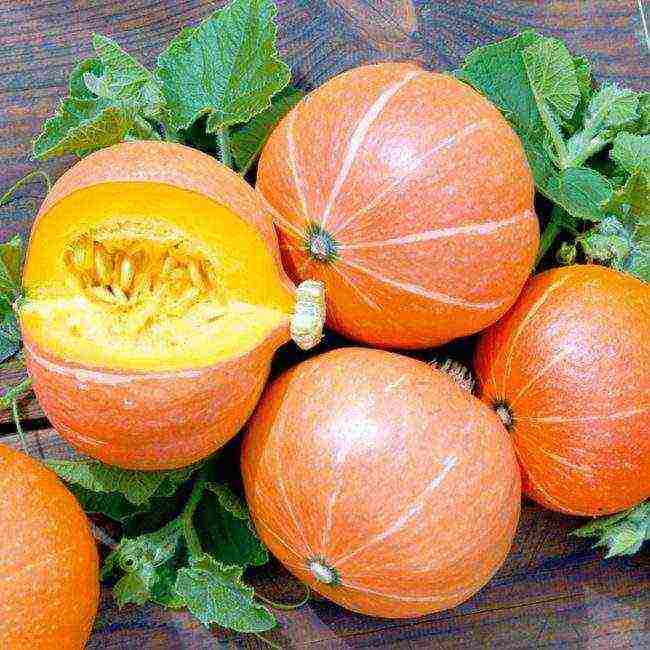
Smile
Also in the Urals, Siberia, you can grow varieties:
- vitamin
- Russian woman
- sweetie
- marble
- almond
- winter dining room, etc.
back to menu ↑ Sweet varieties 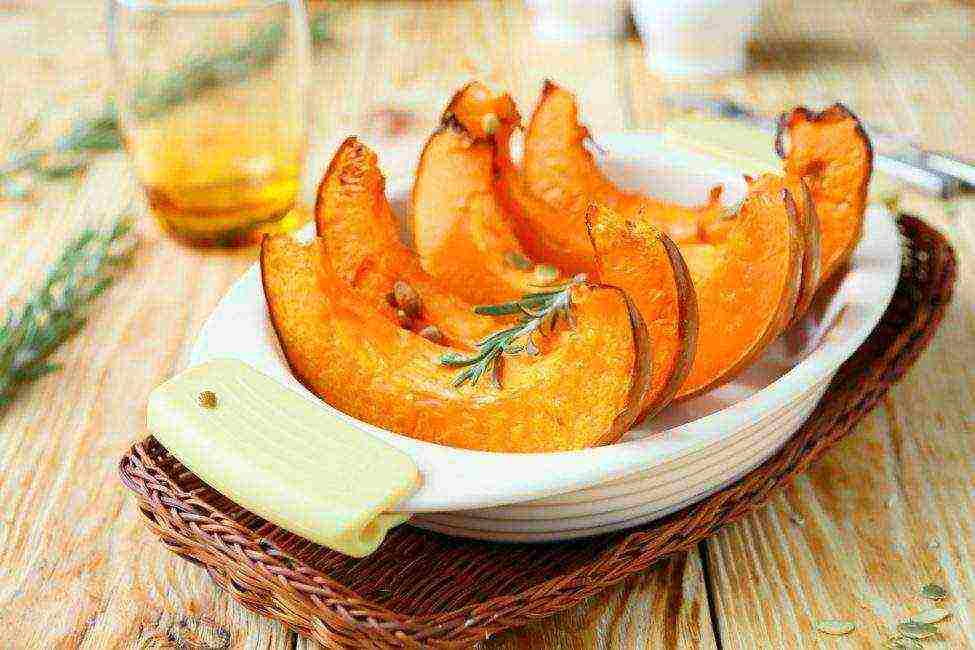
Baked Sweet Pumpkin
Consider some of the varieties included in this group:
back to menu ↑ Winter sweet 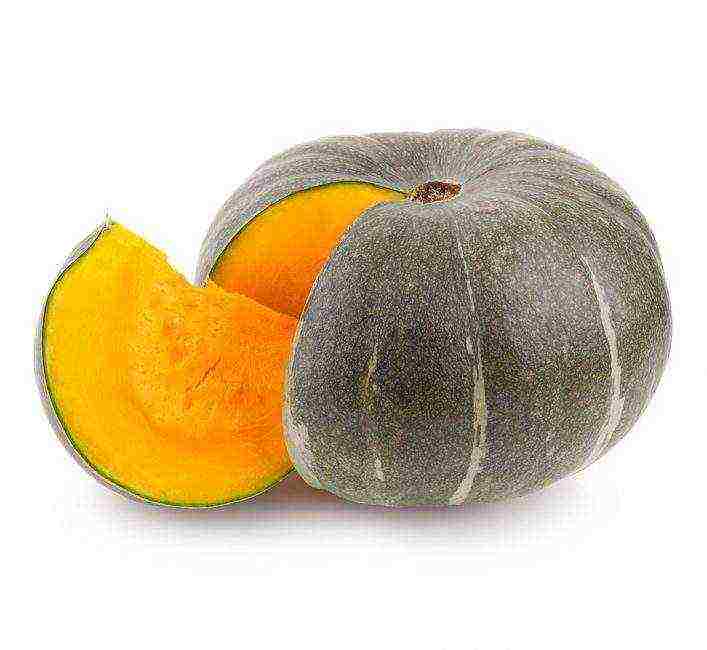
Winter sweet
The variety is considered:
- transportable
- drought tolerant
- suitable for long-term storage - up to 1 year
- resistant to the most famous diseases of pumpkin seeds - anthracnose, powdery mildew
back to menu ↑ Sweetheart 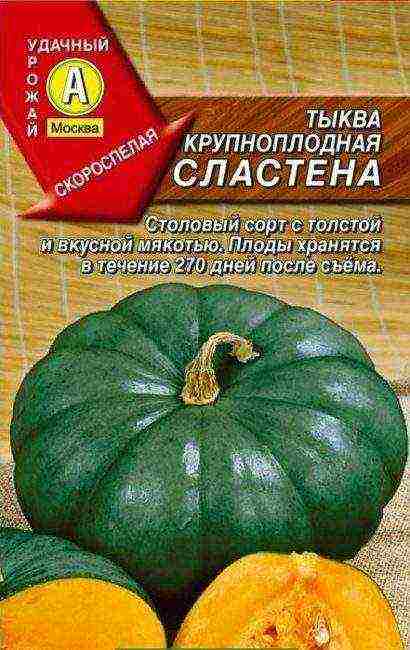
Sweetheart
back to menu ↑ Gray Volzhskaya 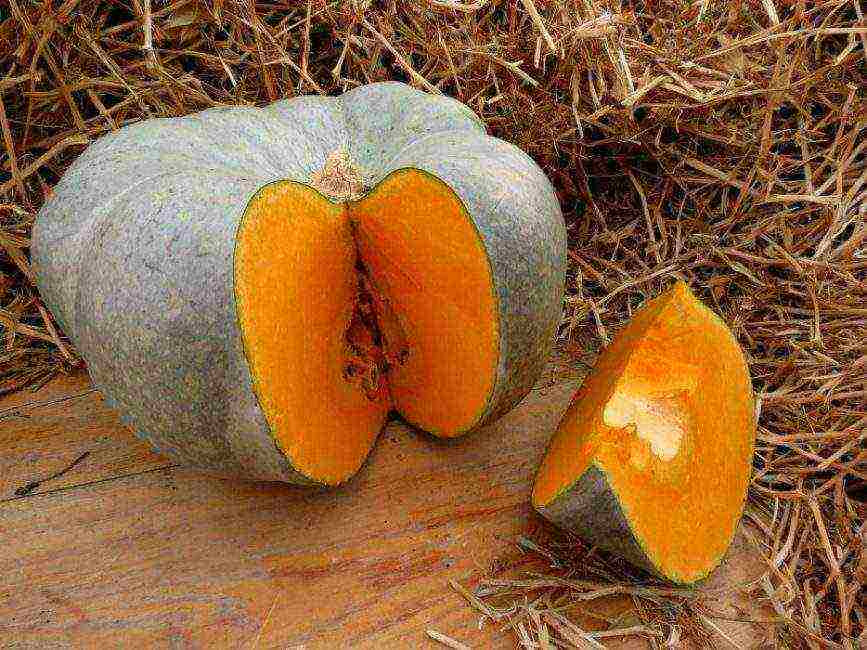
Gray Volga
The seed nest takes up a significant part of the fruit. The variety is considered:
- transportable
- high-yielding
- drought tolerant
back to menu ↑ Honey 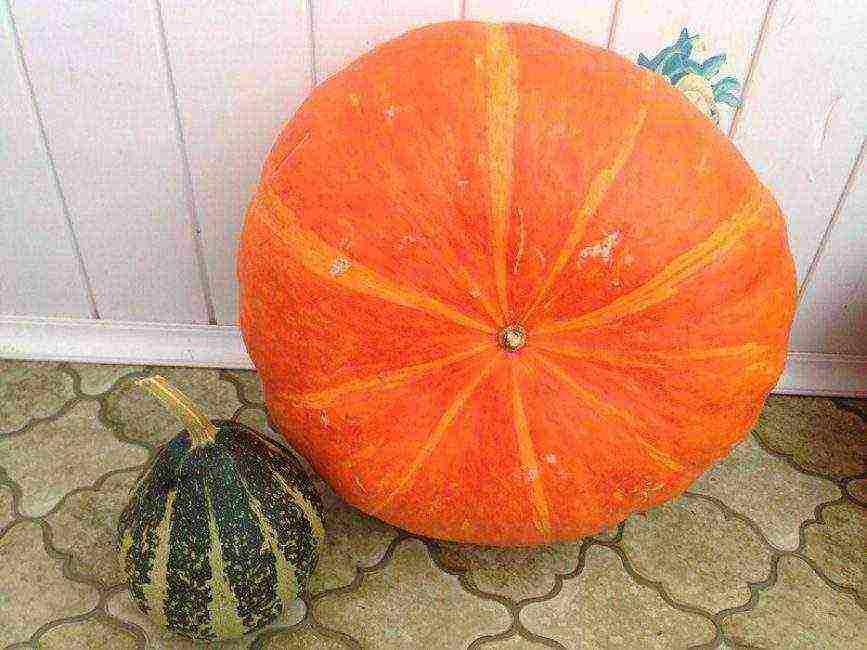
Honey
Honey pumpkin brings together many varieties. The most famous:
- honey tale (princess)
- honey beauty
- honey dessert
back to menu ↑ Candy 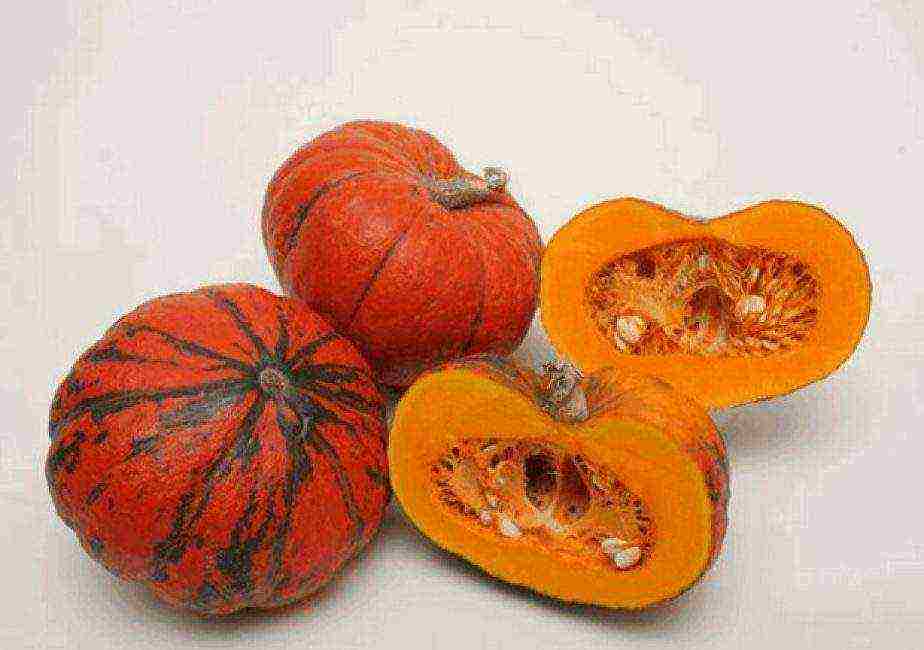
Sweetie
back to menu ↑ Hybrid varieties
Hybrid pumpkins
Let's describe several pumpkin hybrids:
back to menu ↑ Blush F1 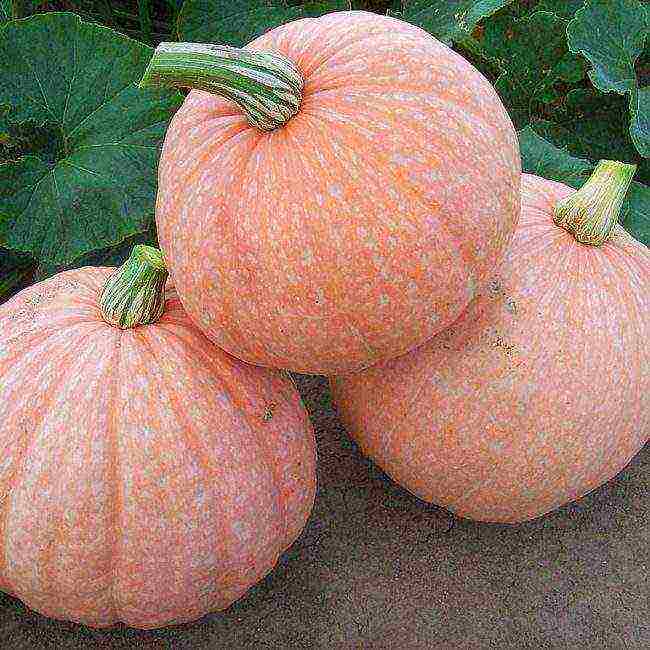
Blush F1
back to menu ↑ Matilda F1 
Matilda F1
The seed nest occupies a small part of the pumpkin. The palatability of the pulp allows it to be used for various purposes:
- for salads
- baking
- stewing, baking, etc.
back to menu ↑ Butter F1 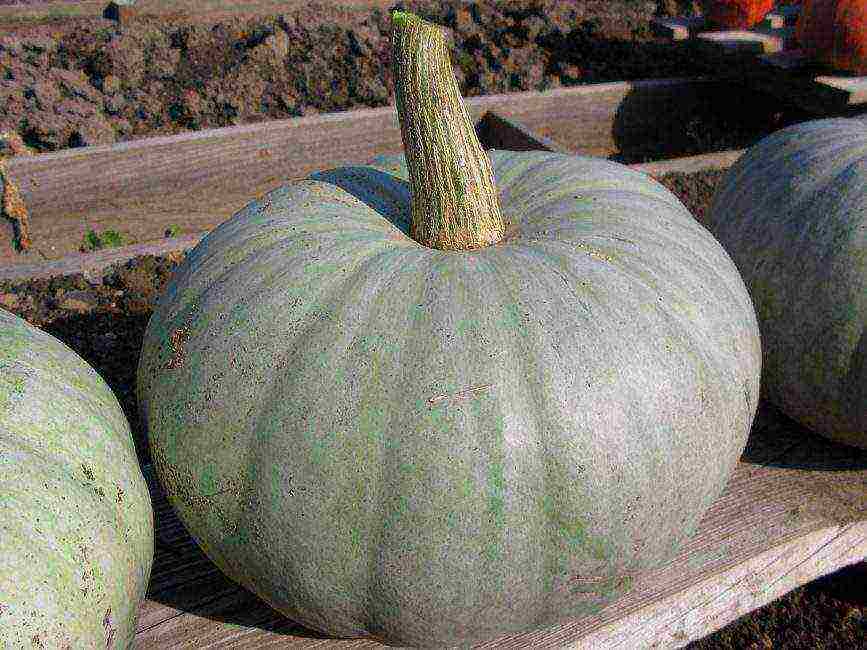
Butter crumpet F1
back to menu ↑ Hazelnut F1 
Hazelnut F1
When choosing a variety, you must consider:
- area where the plant will be grown
- purpose: for storage, as animal feed, etc.
- taste qualities: for desserts, stewing, canning, etc.
8.9 Overall Score
From childhood, every inhabitant of our country knows that pumpkin is one of the most useful vegetables. It is used as a dietary product and is included in the diet of babies. There are many varieties in the world. Each of them has its own positive, negative qualities. We have described the best and most popular pumpkin varieties for you. If you disagree with these ratings, leave your rating in the comments with the reasons for your choice. Thank you for your participation. Your opinion will be useful to other users.
Relevance of information
Availability of application
8.5
Reliability of information
9.5
Add your review
The pumpkin began to be cultivated in Russia in the 16th century. Since then, it is a multipurpose crop that is grown even in regions with harsh climates. When mentioning pumpkin, it is customary to represent round pumpkins of red-orange color. However, in fact, the culture is extremely diverse, there are varieties that differ in color, shape, taste.
To get a rich harvest, it is important to choose the most suitable species.
The best pumpkin varieties

Pumpkin is considered a very popular crop; it can be found on farmlands, dachas, and vegetable gardens. If the variety is selected correctly, problems with its cultivation, as a rule, do not arise. Due to its useful composition and excellent taste, it is cultivated under different climatic conditions. Domestic breeders are developing new varieties that are resistant, they are suitable for the Moscow region, Siberia. In the south, thermophilic varieties of this crop are successfully grown. Each type has its own characteristics of care, description and is not suitable for every region.
Butternut pumpkin varieties
Pumpkins are often cylindrical, less often rounded. The stem is covered with soft bristles. The color of the leaves is green with white spots. It owes its name to the nutmeg aroma of the pulp. The color of ripe fruits is beige, however, during storage they acquire an orange tint. This happens due to an increase in sugar content. It is not suitable for long-term storage, after six months it loses its commercial qualities.
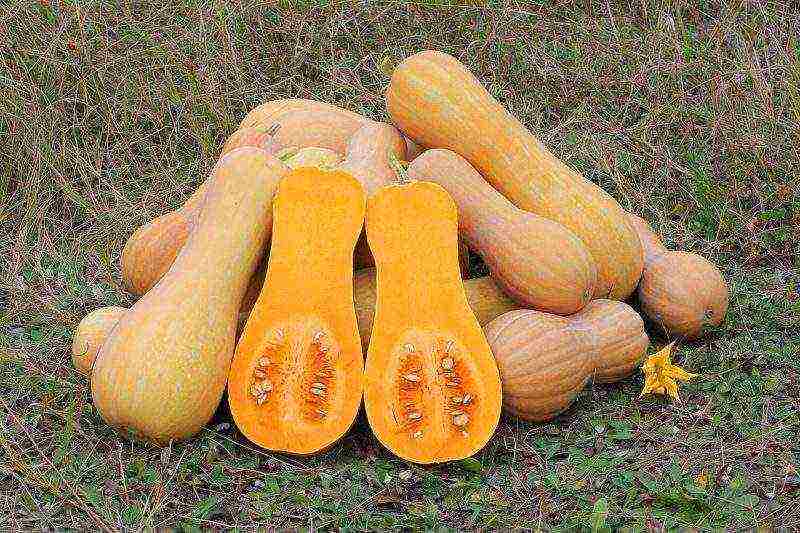
The best representatives of butternut squash:
- Vitamin. It has late-ripening fruits of regular cylindrical shape. Weight 4-6 kg. The bark is brown, thin. Orange pulp rich in carotene, has a sweet taste.
- Candied. Mid-ripening. Grows on long, spreading bushes. When ripe, the bark is light brown. The pulp is bright red.
- Pearl. Early maturing fruits of the nutmeg pearl grow on strong bushes. The pumpkin is cylindrical in shape, more often smooth, less often wavy.
Methods of agrotechnical cultivation of nutmeg varieties do not differ from other pumpkins.
Hard bark gourd
Hard pumpkin is also called a dining room. It is considered the most popular variety among farmers and consumers. Stores well. The plant acquires the shape, taste and color characteristic of a particular variety. The color is usually yellow-orange, stripes are allowed. The bark is quite dense. Pulp, high fiber, sugary. There are oil seeds inside.
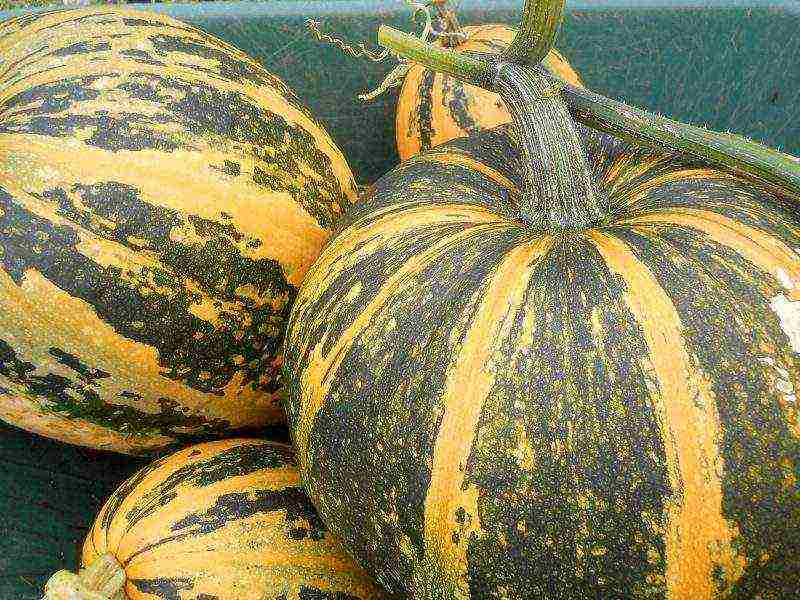
There are several dozen varieties, including:
- Amazon. Ideal for central areas. The crop has medium-sized green foliage. The pumpkins have a regular round shape. It is characterized by a smooth, creamy skin. It tolerates transportation well, can be stored for a long time.
- Freckle. An early variety. Grows on shrubs consisting of short lashes. Leaves with specks.The shape of the pumpkin is round. The pulp is reminiscent of the taste of a pear. Stored for a long time.
- Bush pumpkin 189. Ripens early enough. The bushes form short lashes. Pumpkins - round or oval, have an orange tone with green stripes.
The variety of types of hard-bore pumpkin is amazing, for this reason it is difficult for a gardener to make a choice, so it is worth giving preference to more suitable varieties.
Types of large-fruited pumpkin
Large-fruited pumpkins are considered the most cold-resistant. When mature, the bark can be green, white or pink in color. Inside are pumpkin seeds, which are of the highest value. The bark is medium soft. The pulp is sugary, slightly fibrous, loose.
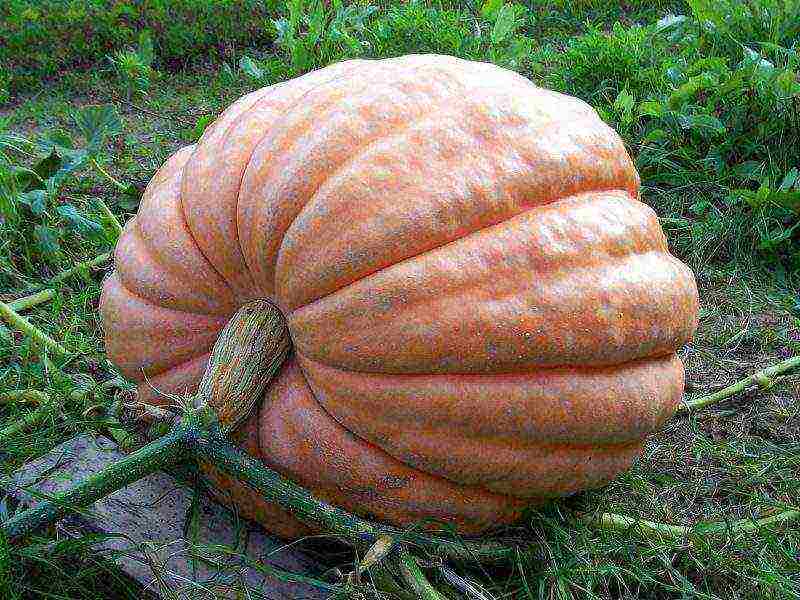
The most popular types:
- Ordinary. The vegetable grows up to 25 kg. Specimens weighing up to 3 kg are considered the sweetest. Pumpkins are round in shape, inherent in a rich orange color.
- Parisian red. Bred in France. Possesses excellent yields. It can weigh 20 kg or more. The bark of the fruit is red, the pulp is lemon. It is successfully used in cooking. The inside is juicy enough.
- Winter sweet. Late view. The bark is gray, inside is bright orange pulp. Perfectly stored, suitable for transportation.
The name "large-fruited" speaks for itself, this species has giant pumpkins, individual fruits reach 1 centner. Differs in high productivity.
Early and late-ripening pumpkin varieties
Experienced gardeners recommend using greenhouse-grown seedlings for an early harvest. Seedlings are planted in open ground after May-June frosts.
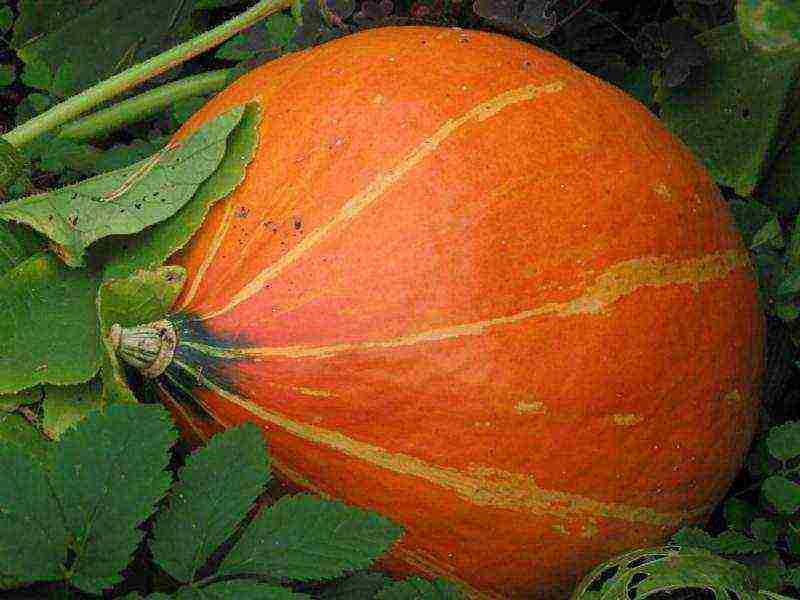
Best early ripening seeds:
- Shrub Gribovskaya 189;
- Barnaul;
- Gymnosperm;
- Ukrainian multiple;
- Freckle;
- Marble pumpkin.
Late ripening fruits are well stored in winter. Sow them directly into the seed beds. Harvested as it ripens. In addition to early and late, there are mid-late pumpkin varieties.

The most common among gardeners are the following types:
- Gribovskaya winter;
- Kherson;
- Vitamin;
- Slavuta;
- Ioannina.
Pumpkin varieties have different uses: table for cooking, for animal feed, oil (for seeds and oil) or decorative.
The best pumpkin varieties for central Russia and the Moscow region
Regardless of where they live, experienced gardeners grow almost all crops, including pumpkin. However, it is not always possible to harvest a good harvest in the middle zone or the Moscow region. This is due to improperly selected varieties.
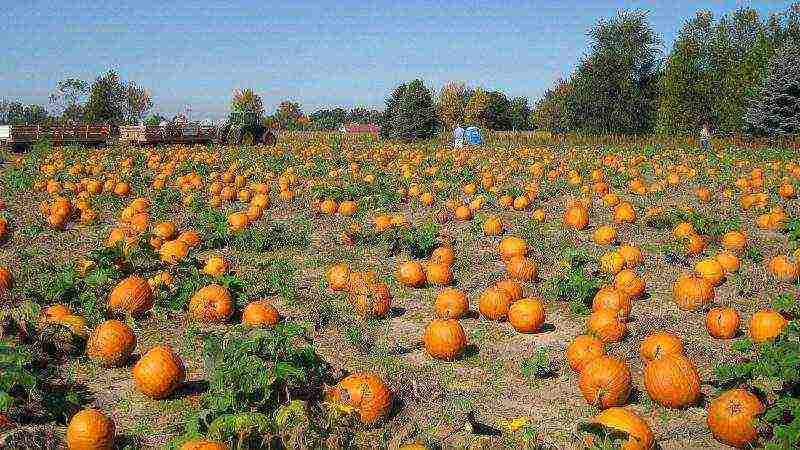
The following seeds were bred by breeders:
- early ripe - Loaf, Russian woman, Kustovaya gold;
- mid and late ripening - Muscat, Medovaya, Aport, Winter sweet.
Correctly selected seeds will allow you to grow a rich pumpkin harvest in any region of Russia, even the harsh Siberian climate is not a hindrance to this!
It is important to plant varieties adapted to temperature extremes in these regions.
What pumpkin to choose for summer residents of Siberia and the Urals
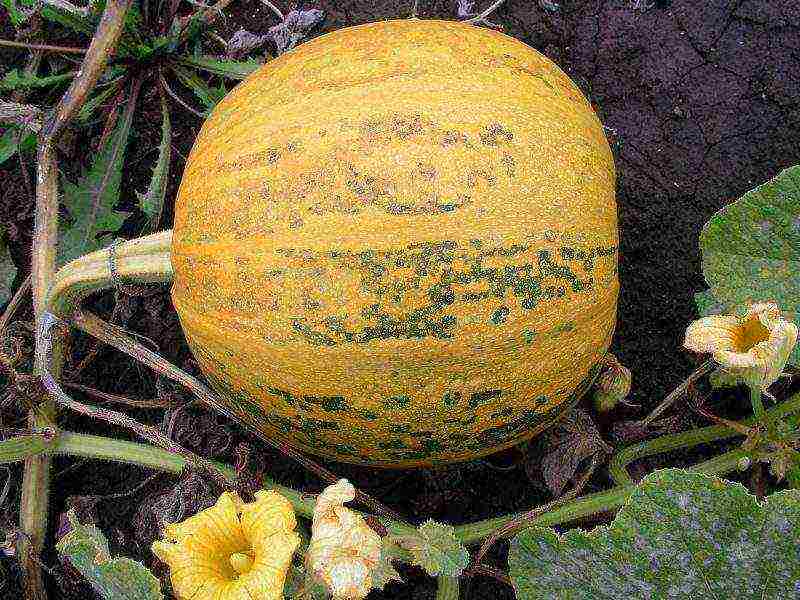
In these regions, pumpkin seeds specially bred by breeders - Altai 47 grow well. The seeds are resistant to low temperatures. The yield is high enough, characterized by excellent transportability. Fruit weight is average (4-5.4 kg). The color of the bark is yellow-green with stripes. The period from planting to harvest is 3.5 months.
Features of caring for pumpkin in the open field
In addition to choosing seeds, gardeners should take care of proper care.

- The soil before planting should be loose, fertilized. The beds should be free of weeds.
- Pumpkin can be grown next to cucumbers, potatoes, bush beans.
- It is necessary to respect the distance between the bushes, each individual variety has its own requirements. Planting distances and dates are always indicated on the seed packages.
- After germination, you need to ensure regular watering, sometimes it is reduced for the flowering period.
- Loosening of the soil is required so that the holes do not dry out in the heat, they are covered with spruce branches (straw).
- So that the culture does not get sick and to protect against pests, the plants are periodically treated with special means, organic matter.
- For feeding, manure or chicken droppings are used from it, a nutrient mixture is prepared in a ratio of 1:10.
Harvesting is carried out when signs of pumpkin ripeness appear, when the bushes dry out, the trunk is corked.
The best sweet pumpkin varieties
Pumpkins with sweet pulp are most in demand in cooking, they are used to prepare juices, all kinds of dishes.

Due to their sugar content, gardeners distinguish the following sweet pumpkin varieties:
- Chit. The fruits are medium-sized, have a flattened shape. Weight up to 2 kg. The color is pale gray. The pulp is very sweet and juicy. It has excellent taste, it can be stored for a long time.
- Atlant. Giant pumpkins can weigh up to 40-50 kg. It has a sugary, very delicate orange pulp. The surface of the fruit is slightly ribbed.
- Almond. A productive variety. Dark orange with stripes. Weight up to 7 kg. Ideal for winter storage.
- Volga gray. Early ripening pumpkins are gray with a green tint. The shape is flattened. The pulp is quite dense, sugary.
To get sweet pumpkins when grown, it is best to place them in the beds on the south side. Places along walls, dense fences, fences are ideal.
Table of types and varieties of pumpkin
| Nutmeg | Vitamin, Candied, Pearl, Pineapple, Fig-leaved, Wax. |
| Hardy | Amazon, Freckle, Gribovskaya bush 189, Spaghetti, Golosemy, Smile. |
| Large-fruited | Ordinary, Parisian red, Winter sweet, One hundred pounds, Marble, Mother-in-law. |
